
[ad_1]
Compiled by Jess Dunks, with contributions from Laurie Cheers, Tom Fowler, Carsten Haese, Nathan Long, and Thijs van Ommen.
Document last modified August 22, 2021
PDF Download Links:
English | 中國話,漢語;中文 | 中国话,汉语;中文 | Français | Deutsch
Italiano | 한글 | Português | русский язык | Español | 日本語
The Release Notes include information concerning the release of new Magic: The Gathering sets, as well as a collection of clarifications and rulings involving cards in those sets. It’s intended to make playing with the new cards more fun by clearing up the common misconceptions and confusion inevitably caused by new mechanics and interactions. As future sets are released, updates to the Magic rules may cause some of this information to become outdated. Go to Magic.Wizards.com/Rules to find the most up-to-date rules.
The “General Notes” section includes information about card legality and explains some of the mechanics and concepts in the set.
The “Card-Specific Notes” sections contain answers to the most important, most common, and most confusing questions players might ask about cards in the set. Items in the “Card-Specific Notes” sections include full card text for your reference. Not all cards in the set are listed.
Card Legality
Innistrad: Midnight Hunt cards with the MID set code are permitted in the Standard, Modern, Pioneer formats, as well as in Commander and other formats. As those cards enter the Standard format, the Throne of Eldraine, Theros Beyond Death, Ikoria: Lair of Behemoths, and Core Set 2021 sets will leave Standard.
Innistrad: Midnight Hunt Commander cards with the MIC set code and numbered 1–38 (and their alternate versions numbered 39–76) are permitted in the Commander, Vintage, and Legacy formats. Cards with the MIC set code numbered 77 and above are legal for play in any format where a card with the same name is permitted.
Go to Magic.Wizards.com/Formats for a complete list of formats and their permitted card sets and banned lists.
Go to Magic.Wizards.com/Commander to learn more about the Commander format and how to play.
Go to Locator.Wizards.com to find an event or store near you.
New Keyword Abilities: Daybound and Nightbound
It wouldn’t be lunacy to say that most interesting things on Innistrad revolve around the moon and, more specifically, the interplay between day and night. These concepts take center stage with two new keywords found on many Werewolves in this set: daybound and nightbound.
(Note: If you haven’t played with transforming double-faced cards before, you may want to skip ahead to the “Returning Mechanic: Transforming Double-Faced Cards” section below and then come back.)
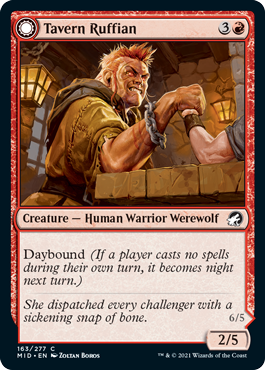
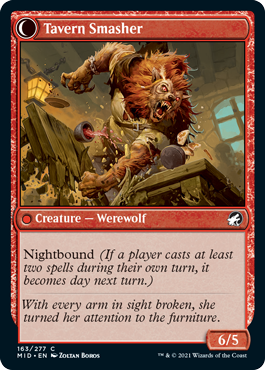
Tavern Ruffian
{3}{R}
Creature — Human Warrior Werewolf
2/5
Daybound (If a player casts no spells during their own turn, it becomes night next turn.)
////
Tavern Smasher
Creature — Werewolf
6/5
Nightbound (If a player casts at least two spells during their own turn, it becomes day next turn.)
Day/Night Overview
Day and night are designations that the game itself can have. The game starts as neither. Once the game becomes day (or less commonly, night), the game will be exactly one of them—day or night—going back and forth for the rest of the game. Double-faced cards with daybound and nightbound care a lot about this. As long as it’s day, the face with daybound will be face up on the battlefield. As long as it’s night, the face with nightbound will be face up on the battlefield.
Becoming Day or Night the First Time
Double-faced cards with daybound and nightbound are transforming double-face cards. They can be cast only face up. In most cases, they’ll first appear on the battlefield front face up. If it’s neither day nor night, and a permanent with daybound appears on the battlefield, it becomes day. Other abilities can also cause it to become day or night, such as Brimstone Vandal’s second ability.
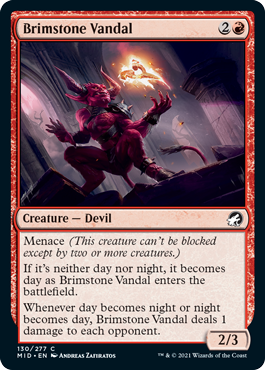
Brimstone Vandal
{2}{R}
Creature — Devil
2/3
Menace (This creature can’t be blocked except by two or more creatures.)
If it’s neither day nor night, it becomes day as Brimstone Vandal enters the battlefield.
Whenever day becomes night or night becomes day, Brimstone Vandal deals 1 damage to each opponent.
Going from Day to Night or Night to Day
Once the game has a day or night designation, whether that designation changes each turn is generally determined by the number of spells the active player cast on the previous turn.
- Before a player untaps their permanents during the untap step, the game checks to see if the day/night designation should change.
- If it is day, and the active player of the previous turn cast no spells during their turn, it becomes night.
- If it is night, and the active player of the previous turn cast two or more spells during their turn, it becomes day.
- Double-faced permanents with daybound transform to their nightbound faces as it becomes night. Similarly, double-faced permanents with nightbound transform to their daybound faces as it becomes day. This happens immediately and is not a state-based action. It happens any time it becomes day or night, not just during the untap step.
Very Important Things to Remember at Night
- If you cast a spell with daybound during night, that spell will be front face up (that is, daybound face up) on the stack. However, it will enter the battlefield with its back face up (that is, with its nightbound face up). It won’t enter with its daybound face up and then transform.
- If it is night, permanents with daybound that enter the battlefield without being cast will enter with their nightbound faces up.
Putting the “Bound” in Daybound and Nightbound
- Permanents with daybound and nightbound can’t transform via any means other than their daybound and nightbound abilities. Notably, older cards such as Moonmist that instruct a player to transform permanents don’t affect permanents with daybound or nightbound.
- Once it has become day or become night, the game will have exactly one of those designations until the game is over. It can never be both day and night at the same time. Once it is day or night, the game can’t return to being neither.
- The whole game is day or the whole game is night. It won’t ever be day for one player and night for another.
One of the Most Unusual Cases We Could Think Of, And Someone Would Ask
- If it’s neither day nor night, and a creature with daybound and a creature with nightbound somehow appear on the battlefield at the same time, it becomes day. The creature with nightbound will transform.
New Keyword Ability: Disturb
Werewolves aside, there’s lots of other spooky double-faced-card action going on in this set. A new keyword ability, disturb, allows you to cast the back faces of certain double-faced cards from your graveyard.
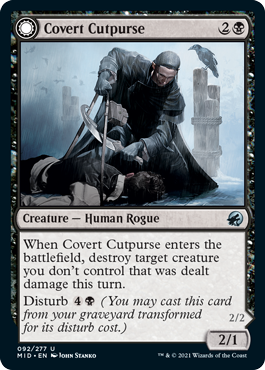
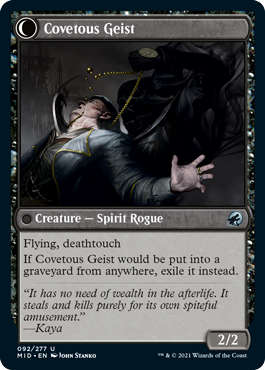
Covert Cutpurse
{2}{B}
Creature — Human Rogue
2/1
When Covert Cutpurse enters the battlefield, destroy target creature you don’t control that was dealt damage this turn.
Disturb {4}{B} (You may cast this card from your graveyard transformed for its disturb cost.)
////
Covetous Geist
Creature — Spirit Rogue
2/2
Flying, deathtouch
If Covetous Geist would be put into a graveyard from anywhere, exile it instead.
- Disturb is found only on the front faces of some double-faced cards.
- “Disturb [cost]” means “You may cast this card transformed from your graveyard by paying [cost] rather than its mana cost.”
- When you cast a spell using a card’s disturb ability, the card is put onto the stack with its back face up. The resulting spell has all the characteristics of that face.
- To determine the total cost of a spell, start with the mana cost or alternative cost (such as a disturb cost) you’re paying, add any cost increases, then apply any cost reductions. The mana value of a spell cast using disturb is determined by the mana cost on the front face of the card, no matter what the total cost to cast the spell was. (This is a special rule that applies only to transforming double faced-cards, including ones with disturb.)
- A spell cast this way enters the battlefield with its back face up.
- If you copy a permanent spell cast this way (perhaps with a card like Double Major), the copy becomes a token that’s a copy of the card’s back face, even though it isn’t itself a double-faced card.
- The back face of each card with disturb has an ability that instructs its controller to exile if it would be put into a graveyard from anywhere. This includes going to the graveyard from the stack, so if the spell is countered after you cast it using the disturb ability, it will be put into exile.
Returning Mechanic: Transforming Double-Faced Cards
The plane of Innistrad wouldn’t be complete without the transformation of scary, spooky things into other scary, spooky things, and so transforming double-faced cards return in this set.
A double-faced card has two faces: a front face and a back face. It doesn’t have a Magic card back. A transforming double-faced card from this set has a sun symbol in the upper-left corner of its front face and a moon symbol in the upper-left corner of its back face. Other than distinguishing one face from another, these symbols have no effect on game play.
Unlike the modal double-faced cards found in some recent sets, the back faces of transforming double-faced cards don’t have a mana cost and can’t be cast (although the disturb ability in this set carves out an exception). They can, however, transform. To transform a card is to turn it from its front face to its back face, or vice versa.
Double-faced cards undergo some minor changes with the release of Innistrad: Midnight Hunt, but they still function largely how they did the last time we saw them. Here is some more info:
- Each face of a transforming double-faced card has its own set of characteristics: name, types, subtypes, abilities, and so on. While a transforming double-faced permanent is on the battlefield, consider only the characteristics of the face that’s currently up. The other set of characteristics is ignored.
- Transforming double-faced cards are cast face up unless they’re being cast using the disturb ability. Consider only the characteristics of the face that’s up; the other face’s characteristics are ignored.
- While a transforming double-faced card isn’t on the battlefield or on the stack, consider only the characteristics of its front face.
- The mana value of a transforming double-faced card is the mana value of its front face, no matter which face is up.
- The back face of a transforming double-faced card usually has a color indicator that defines its color.
- The back face of a transforming double-faced card can’t be cast unless an effect allows you to cast it “transformed.” (See the “New Keyword Ability: Disturb” section of this document.)
- A transforming double-faced card enters the battlefield with its front face up by default, unless a spell or ability instructs you to put it onto the battlefield transformed or you cast it transformed, in which case it enters with its back face up.
- To transform a permanent, turn it over so that its other face is up. Only permanents represented by transforming double-faced cards can transform.
- If you are instructed to transform a permanent that isn’t represented by a double-faced card, perhaps because it’s a token or a single-faced card that has become a copy of a double-faced permanent, that instruction is ignored.
- Transforming a permanent doesn’t affect any Auras or Equipment attached to that permanent. Similarly, any counters on the permanent will remain on that permanent after it transforms. Any continuous effects from a resolved spell or ability will continue to affect it. Any spells or abilities on the stack that target a permanent continue to do so after that permanent transforms.
- Damage marked on a double-faced permanent will stay marked on that permanent after it transforms.
New Ability Word: Coven
Coven is an ability word found on cards with abilities that care about controlling three or more creatures with different powers.
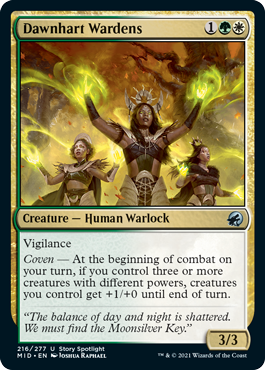
Dawnhart Wardens
{1}{G}{W}
Creature — Human Warlock
3/3
Vigilance
Coven — At the beginning of combat on your turn, if you control three or more creatures with different powers, creatures you control get +1/+0 until end of turn.
- A creature has different power from another if their powers are different numbers. For example, a 1/1 creature and a 2/1 creature have different powers.
- For three creatures to have different powers from one another, each of their powers needs to be different. A 1/1 creature, a 2/1 creature, and another 2/1 creature aren’t three creatures with different powers, even though both 2/1 creatures have different power than the 1/1 creature.
- Many coven abilities, such as that of Dawnhart Wardens above, are triggered abilities with intervening if clauses. You must control three or more creatures with different powers at the time the ability triggers and at the time the ability tries to resolve. They do not, however, need to be the same set of creatures in both cases.
New Dual Land Cycle
Innistrad: Midnight Hunt introduces a cycle of nonbasic lands that enter the battlefield tapped unless you control two or more other lands.
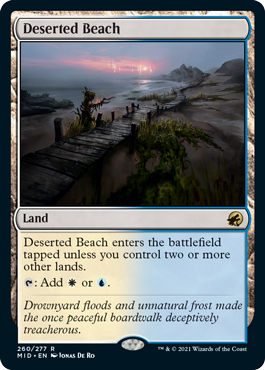
Deserted Beach
Land
Deserted Beach enters the battlefield tapped unless you control two or more other lands.
{T}: Add {W} or {U}.
- If one of these lands enters the battlefield at the same time as any number of other lands, those other lands are not counted when determining if this land enters the battlefield tapped or untapped.
New Keyword Ability: Decayed
Decayed is a keyword ability that appears on most Zombie creature tokens created by cards in this set, as well as in a few effects that cause creatures to become Zombies.
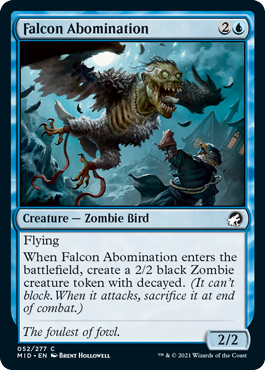
Falcon Abomination
{2}{U}
Creature — Zombie Bird
2/2
Flying
When Falcon Abomination enters the battlefield, create a 2/2 black Zombie creature token with decayed. (It can’t block. When it attacks, sacrifice it at end of combat.)
- Decayed represents a static ability and a triggered ability. “Decayed” means “This creature can’t block” and “When this creature attacks, sacrifice it at end of combat.”
- Decayed does not create any attacking requirements. You may choose not to attack with a creature that has decayed.
- Decayed does not grant haste. Creatures with decayed that enter the battlefield during your turn may not attack until your next turn.
- Once a creature with decayed attacks, it will be sacrificed at end of combat, even if it no longer has decayed at that time.
Returning Keyword Ability: Flashback
Flashback is a returning mechanic that gives cards a second chance to have an impact.
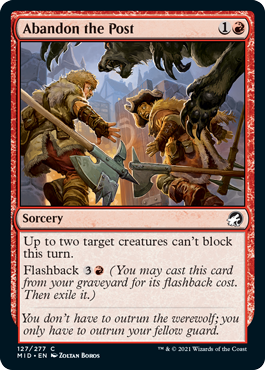
Abandon the Post
{1}{R}
Sorcery
Up to two target creatures can’t block this turn.
Flashback {3}{R} (You may cast this card from your graveyard for its flashback cost. Then exile it.)
- “Flashback [cost]” means “You may cast this card from your graveyard by paying [cost] rather than paying its mana cost” and “If the flashback cost was paid, exile this card instead of putting it anywhere else any time it would leave the stack.”
- You must still follow any timing restrictions and permissions, including those based on the card’s type. For instance, you can cast a sorcery using flashback only when you could normally cast a sorcery.
- To determine the total cost of a spell, start with the mana cost or alternative cost (such as a flashback cost) you’re paying, add any cost increases, then apply any cost reductions. The mana value of the spell is determined only by its mana cost, no matter what the total cost to cast the spell was.
- A spell cast using flashback will always be exiled afterward, whether it resolves, is countered, or leaves the stack in some other way.
- You can cast a spell using flashback even if it was somehow put into your graveyard without having been cast.
- If a card with flashback is put into your graveyard during your turn, you can cast it if it’s legal to do so before any other player can take any actions.
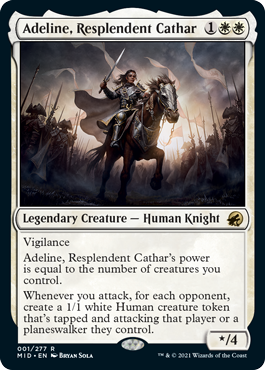
Adeline, Resplendent Cathar
{1}{W}{W}
Legendary Creature — Human Knight
*/4
Vigilance
Adeline, Resplendent Cathar’s power is equal to the number of creatures you control.
Whenever you attack, for each opponent, create a 1/1 white Human creature token that’s tapped and attacking that player or a planeswalker they control.
- The ability that defines Adeline’s power works in all zones, not just the battlefield. As long as Adeline is on the battlefield (and still a creature), that ability will count Adeline itself.
- Attacking with any creatures will cause Adeline’s last ability to trigger. Adeline doesn’t have to be among them.
- Tokens will be created for each of your opponents, not just opponents that you attacked.
- You choose whether each token is attacking that opponent or a planeswalker they control as those tokens enter the battlefield.
- Although the Human tokens created by the triggered ability are attacking, they were never declared as attacking creatures (for the purposes of abilities that trigger whenever a creature attacks, for example).
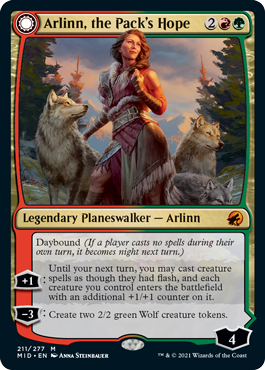
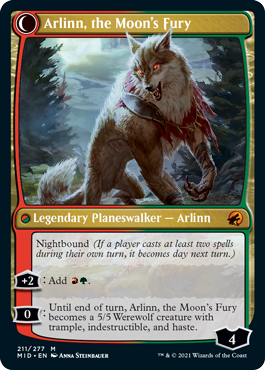
Arlinn, the Pack’s Hope
{2}{R}{G}
Legendary Planeswalker — Arlinn
4
Daybound (If a player casts no spells during their own turn, it becomes night next turn.)
+1: Until your next turn, you may cast creature spells as though they had flash, and each creature you control enters the battlefield with an additional +1/+1 counter on it.
−3: Create two 2/2 green Wolf creature tokens.
////
Arlinn, the Moon’s Fury
Legendary Planeswalker — Arlinn
4
Nightbound (If a player casts at least two spells during their own turn, it becomes day next turn.)
+2: Add {R}{G}.
0: Until end of turn, Arlinn, the Moon’s Fury becomes a 5/5 Werewolf creature with trample, indestructible, and haste.
- Arlinn, the Moon’s Fury’s first loyalty ability is not a mana ability. It uses the stack and may be responded to.
- After Arlinn, the Moon Fury’s second loyalty ability resolves, she is a Werewolf creature and not a planeswalker, so she doesn’t lose loyalty counters when she’s dealt damage.
- If Arlinn, the Moon Fury’s second loyalty ability is making her a Werewolf creature and it somehow becomes day, Arlinn will transform, but the effect making her a Werewolf creature will continue to apply for the rest of the turn.
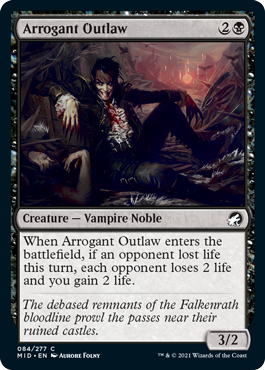
Arrogant Outlaw
{2}{B}
Creature — Vampire Noble
3/2
When Arrogant Outlaw enters the battlefield, if an opponent lost life this turn, each opponent loses 2 life and you gain 2 life.
- Arrogant Outlaw’s ability cares whether an opponent lost life this turn, not how their life total changed. For example, an opponent who gained 2 life and lost 1 life in the same turn still lost life.
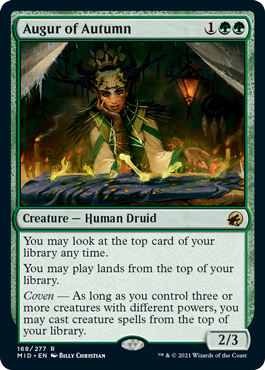
Augur of Autumn
{1}{G}{G}
Creature — Human Druid
2/3
You may look at the top card of your library any time.
You may play lands from the top of your library.
Coven — As long as you control three or more creatures with different powers, you may cast creature spells from the top of your library.
- Augur of Autumn doesn’t change the times when you can play a land card from the top of your library. You can play a land only during your main phase when you have priority and the stack is empty. Doing so counts as your land play for the turn.
- The top card of your library isn’t in your hand, so you can’t suspend it, cycle it, discard it, or activate any of its activated abilities.
- Essentially, Augur of Autumn lets you play with the top card of your library revealed only to you. Knowing what that card is becomes part of the information you have access to, just like you can look at the cards in your hand. You may look at the top card of your library whenever you want, even if you don’t have priority. This action doesn’t use the stack.
- If the top card of your library changes during the process of casting a spell or activating an ability, you can’t look at the new top card until the process of casting the spell or activating the ability ends (all targets are chosen, all costs are paid, and so on).
- While you have three creatures with different powers, Augur of Autumn allows you to cast the top card of your library if it’s a creature card, it’s your main phase, and the stack is empty. If that creature card has flash, you’ll be able to cast it any time you could cast an instant, even on an opponent’s turn.
- You still pay all costs for that spell, including additional costs. You may also pay alternative costs.
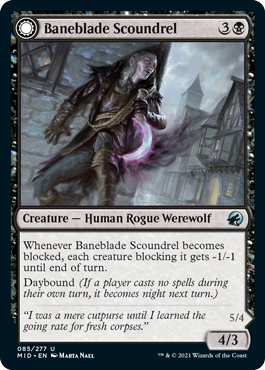
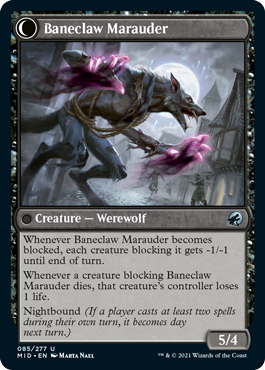
Baneblade Scoundrel
{3}{B}
Creature — Human Rogue Werewolf
4/3
Whenever Baneblade Scoundrel becomes blocked, each creature blocking it gets -1/-1 until end of turn.
Daybound (If a player casts no spells during their own turn, it becomes night next turn.)
////
Baneclaw Marauder
Creature — Werewolf
5/4
Whenever Baneclaw Marauder becomes blocked, each creature blocking it gets -1/-1 until end of turn.
Whenever a creature blocking Baneclaw Marauder dies, that creature’s controller loses 1 life.
Nightbound (If a player casts at least two spells during their own turn, it becomes day next turn.)
- Abilities that trigger when a creature “becomes blocked” resolve before combat damage is dealt.
- A blocked attacker remains blocked even if all blockers are destroyed before combat damage. If there are no blockers blocking it, it won’t deal combat damage, unless it has trample.
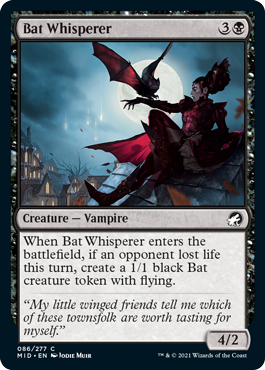
Bat Whisperer
{3}{B}
Creature — Vampire
4/2
When Bat Whisperer enters the battlefield, if an opponent lost life this turn, create a 1/1 black Bat creature token with flying.
- Bat Whisperer’s ability cares whether an opponent lost life this turn, not how their life total changed. For example, an opponent who gained 2 life and lost 1 life in the same turn still lost life.
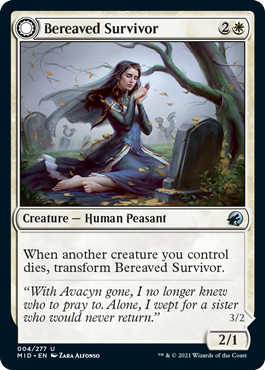
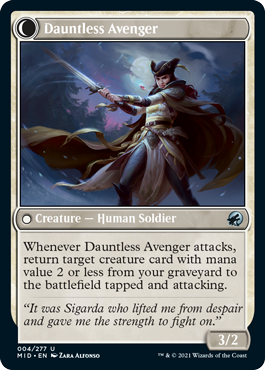
Bereaved Survivor
{2}{W}
Creature — Human Peasant
2/1
When another creature you control dies, transform Bereaved Survivor.
////
Dauntless Avenger
Creature — Human Soldier
3/2
Whenever Dauntless Avenger attacks, return target creature card with mana value 2 or less from your graveyard to the battlefield tapped and attacking.
- Multiple creatures dying will cause Bereaved Survivor to transform only once.
- You choose which player or planeswalker the returned creature is attacking. It doesn’t have to be attacking the same player or planeswalker Dauntless Avenger is attacking.
- Although the returned creature is an attacking creature, it was never declared as an attacking creature. This means that abilities that trigger whenever a creature attacks won’t trigger when it enters the battlefield attacking.
- Effects that say that the returned creature can’t attack (if the creature has defender, for example) affect only the declaration of attackers. They won’t stop the returned creature from entering the battlefield attacking.
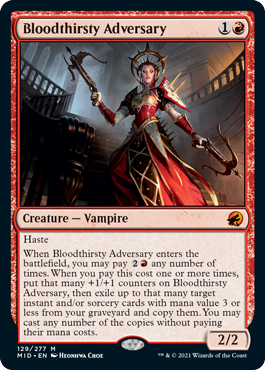
Bloodthirsty Adversary
{1}{R}
Creature — Vampire
2/2
Haste
When Bloodthirsty Adversary enters the battlefield, you may pay {2}{R} any number of times. When you pay this cost one or more times, put that many +1/+1 counters on Bloodthirsty Adversary, then exile up to that many target instant and/or sorcery cards with mana value 3 or less from your graveyard and copy them. You may cast any number of the copies without paying their mana costs.
- After you pay the {2}{R} cost one or more times, a second ability triggers and you choose the targets for it. Players may respond to the new ability at that point. As that ability resolves, Bloodthirsty Adversary gets its counters and the target cards are exiled.
- Whether or not you cast the copies this way, the original cards will remain in exile.
- Copies cast this way are cast during the resolution of the ability. You don’t have to follow normal timing requirements and you can’t wait and cast them later.
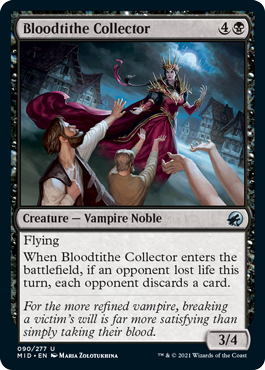
Bloodtithe Collector
{4}{B}
Creature — Vampire Noble
3/4
Flying
When Bloodtithe Collector enters the battlefield, if an opponent lost life this turn, each opponent discards a card.
- Bloodtithe Collector’s triggered ability cares whether an opponent lost life this turn, not how their life total changed. For example, an opponent who gained 2 life and lost 1 life in the same turn still lost life.
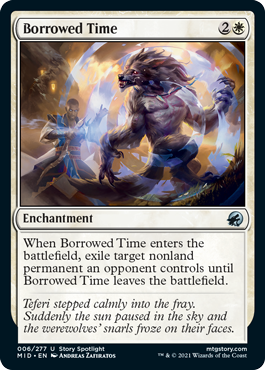
Borrowed Time
{2}{W}
Enchantment
When Borrowed Time enters the battlefield, exile target nonland permanent an opponent controls until Borrowed Time leaves the battlefield.
- Borrowed Time’s ability is a single ability that creates two one-shot effects: one that exiles the permanent when the ability resolves, and another that returns the exiled card to the battlefield immediately after Borrowed Time leaves the battlefield.
- If Borrowed Time leaves the battlefield before its enters-the-battlefield ability resolves, the target permanent won’t be exiled.
- Auras attached to the exiled permanent will be put into their owners’ graveyards. Equipment attached to an exiled creature will become unattached and remain on the battlefield. Any counters on the exiled permanent will cease to exist.
- If a token is exiled, it ceases to exist. It won’t be returned to the battlefield.
- In a multiplayer game, if Borrowed Time’s owner leaves the game, the exiled card will return to the battlefield. Because the one-shot effect that returns the card isn’t an ability that goes on the stack, it won’t cease to exist along with the leaving player’s spells and abilities on the stack.
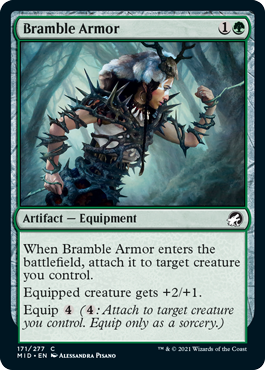
Bramble Armor
{1}{G}
Artifact — Equipment
When Bramble Armor enters the battlefield, attach it to target creature you control.
Equipped creature gets +2/+1.
Equip {4} ({4}: Attach to target creature you control. Equip only as a sorcery.)
- Attaching an Equipment with its enters-the-battlefield triggered ability isn’t the same as using its equip ability. You don’t pay mana for the attachment, and the timing restrictions for equip abilities don’t apply.
- If the target creature becomes an illegal target, the Equipment remains on the battlefield unattached.
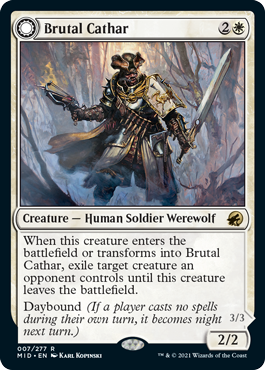
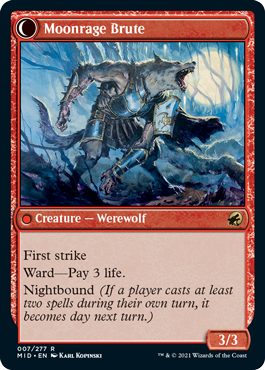
Brutal Cathar
{2}{W}
Creature — Human Soldier Werewolf
2/2
When this creature enters the battlefield or transforms into Brutal Cathar, exile target creature an opponent controls until this creature leaves the battlefield.
Daybound (If a player casts no spells during their own turn, it becomes night next turn.)
////
Moonrage Brute
Creature — Werewolf
3/3
First strike
Ward—Pay 3 life.
Nightbound (If a player casts at least two spells during their own turn, it becomes day next turn.)
- Brutal Cathar’s ability creates two one-shot effects: one that exiles the creature when the ability resolves, and another that returns the exiled card to the battlefield immediately after Brutal Cathar (or Moonrage Brute) leaves the battlefield.
- If Brutal Cathar leaves the battlefield before its enters-the-battlefield/transforms-into ability resolves, the target creature won’t be exiled.
- A transforming permanent doesn’t leave the battlefield as it transforms. If Brutal Cathar transforms into Moonrage Brute, the exiled cards remain exiled. If it transforms with its triggered ability on the stack, that ability will still exile the target creature.
- Moonrage Brute leaving the battlefield will also cause the exiled card to return to the battlefield.
- Auras attached to the exiled creature will be put into their owners’ graveyards. Equipment attached to the exiled creature will become unattached and remain on the battlefield. Any counters on the exiled creature will cease to exist.
- If a creature token is exiled, it ceases to exist. It won’t be returned to the battlefield.
- The exiled card returns to the battlefield immediately after this creature leaves the battlefield. Nothing happens between the two events, including state-based actions. The two creatures aren’t on the battlefield at the same time. For example, if the returning creature is a Clone, it can’t enter the battlefield as a copy of Brutal Cathar or Moonrage Brute.
- In a multiplayer game, if Brutal Cathar’s owner leaves the game, the exiled card will return to the battlefield. Because the one-shot effect that returns the card isn’t an ability that goes on the stack, it won’t cease to exist along with the leaving player’s spells and abilities on the stack.
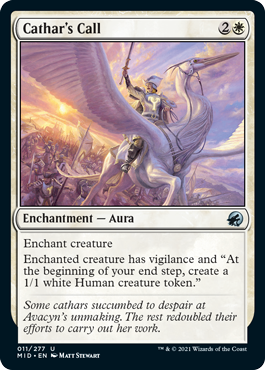
Cathar’s Call
{2}{W}
Enchantment — Aura
Enchant creature
Enchanted creature has vigilance and “At the beginning of your end step, create a 1/1 white Human creature token.”
- The controller of the enchanted creature creates the Human token, even if they aren’t the controller of Cathar’s Call.
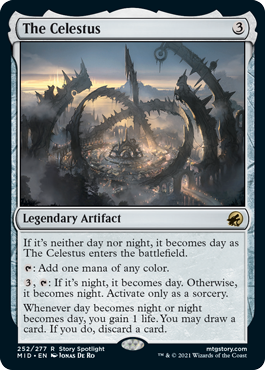
The Celestus
{3}
Legendary Artifact
If it’s neither day nor night, it becomes day as The Celestus enters the battlefield.
{T}: Add one mana of any color.
{3}, {T}: If it’s night, it becomes day. Otherwise, it becomes night. Activate only as a sorcery.
Whenever day becomes night or night becomes day, you gain 1 life. You may draw a card. If you do, discard a card.
- If you choose to draw a card with The Celestus but some effect replaces that card draw with something else, you will still have to discard a card.
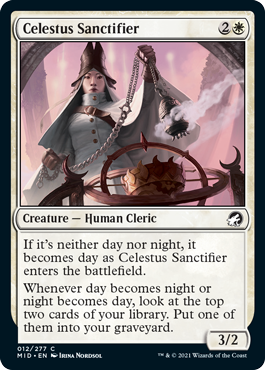
Celestus Sanctifier
{2}{W}
Creature — Human Cleric
3/2
If it’s neither day nor night, it becomes day as Celestus Sanctifier enters the battlefield.
Whenever day becomes night or night becomes day, look at the top two cards of your library. Put one of them into your graveyard.
- The card you don’t put into your graveyard stays on top of your library.
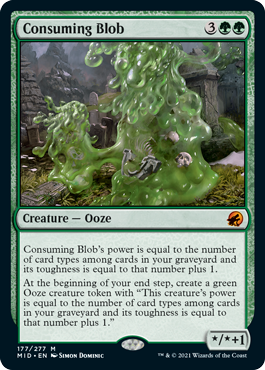
Consuming Blob
{3}{G}{G}
Creature — Ooze
*/*+1
Consuming Blob’s power is equal to the number of card types among cards in your graveyard and its toughness is equal to that number plus 1.
At the beginning of your end step, create a green Ooze creature token with “This creature’s power is equal to the number of card types among cards in your graveyard and its toughness is equal to that number plus 1.”
- The ability that defines Consuming Blob’s power and toughness works in all zones, not just the battlefield. If Consuming Blob is in your graveyard, it will count itself.
- Consuming Blob counts card types, not individual cards. If the only card in your graveyard is an artifact creature card, Consuming Blob will be 2/3. If the only cards in your graveyard are ten artifact creature cards, Consuming Blob will still be 2/3.
- The card types in this set that can be in a graveyard are artifact, creature, enchantment, instant, land, planeswalker, and sorcery. Some older cards also have the card type tribal. Legendary, basic, and snow are supertypes, not card types.
- If an instant or sorcery spell deals damage to Consuming Blob or reduces its toughness to 0, that spell is put into its owner’s graveyard before state-based actions are performed. If that card is the first of its type to enter the graveyard of Consuming Blob’s controller, it will raise Consuming Blob’s toughness before the game checks to see if it dies.
- The above rulings are also true for Consuming Blob’s children (except the first one, as Junior tends to not hang out in graveyards).
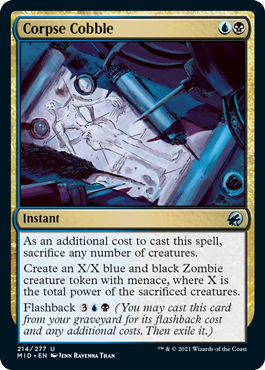
Corpse Cobble
{U}{B}
Instant
As an additional cost to cast this spell, sacrifice any number of creatures.
Create an X/X blue and black Zombie creature token with menace, where X is the total power of the sacrificed creatures.
Flashback {3}{U}{B} (You may cast this card from your graveyard for its flashback cost and any additional costs. Then exile it.)
- You may choose to sacrifice no creatures to pay the additional cost. If you do, you’ll create a 0/0 Zombie token. Unless something else is raising its toughness, the token will subsequently die, but any “enters the battlefield” or “dies” triggered abilities will still trigger.
- If you cast Corpse Cobble using flashback, you still pay its additional cost of sacrificing any number of creatures.
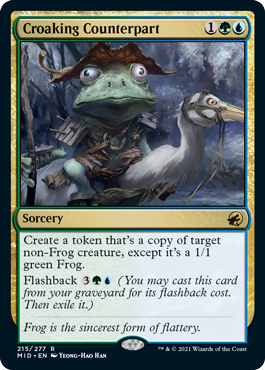
Croaking Counterpart
{1}{G}{U}
Sorcery
Create a token that’s a copy of target non-Frog creature, except it’s a 1/1 green Frog.
Flashback {3}{G}{U} (You may cast this card from your graveyard for its flashback cost. Then exile it.)
- Except for power, toughness, creature type, and color, the token copies exactly what was printed on the original creature and nothing else (unless that permanent is copying something else or it is a token; see below). It doesn’t copy whether that creature is tapped or untapped, whether it has any counters on it or Auras and Equipment attached to it, and so on.
- If the copied creature has {X} in its mana cost, X is considered to be 0.
- If the copied creature is a token, the new token that’s created copies the original characteristics of that token as stated by the effect that created that token, with the exceptions noted above.
- If the copied creature is copying something else, then the token enters the battlefield as whatever that creature copied, with the exceptions noted above.
- Any enters-the-battlefield abilities of the copied creature will trigger when the token enters the battlefield. Any “as [this creature] enters the battlefield” or “[this creature] enters the battlefield with” abilities of the chosen creature will also work.
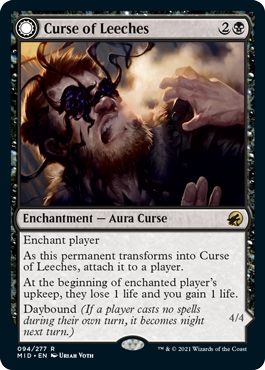
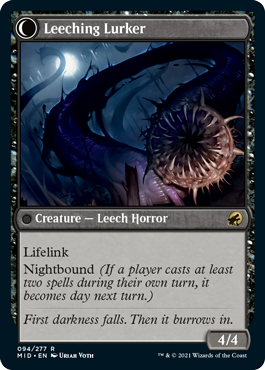
Curse of Leeches
{2}{B}
Enchantment — Aura Curse
Enchant player
As this permanent transforms into Curse of Leeches, attach it to a player.
At the beginning of enchanted player’s upkeep, they lose 1 life and you gain 1 life.
Daybound (If a player casts no spells during their own turn, it becomes night next turn.)
////
Leeching Lurker
Creature — Leech Horror
4/4
Lifelink
Nightbound (If a player casts at least two spells during their own turn, it becomes day next turn.)
- If Leeching Lurker is on the battlefield during night, and the active player casts two or more spells during the turn, it will become day as the next turn begins. This will cause Leeching Lurker to transform into Curse of Leeches and become attached to a player. This all happens before that turn’s upkeep, so the triggered ability of Curse of Leeches will trigger at the beginning of that turn’s upkeep.
- Attaching Curse of Leeches as it transforms doesn’t target a player, so it can be attached to a player with hexproof this way.
- After Curse of Leeches transforms into Leeching Lurker, it will become unattached from the player it’s attached to as a state-based action.
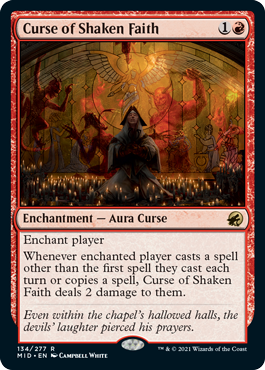
Curse of Shaken Faith
{1}{R}
Enchantment — Aura Curse
Enchant player
Whenever enchanted player casts a spell other than the first spell they cast each turn or copies a spell, Curse of Shaken Faith deals 2 damage to them.
- If a player who has already cast a spell this turn becomes enchanted by Curse of Shaken Faith, casting more spells the same turn will cause the ability to trigger.
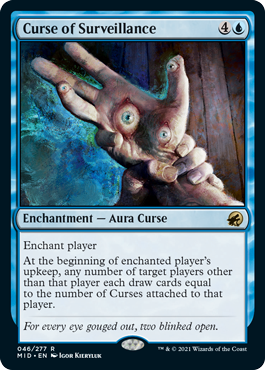
Curse of Surveillance
{4}{U}
Enchantment — Aura Curse
Enchant player
At the beginning of enchanted player’s upkeep, any number of target players other than that player each draw cards equal to the number of Curses attached to that player.
- The controller of Curse of Surveillance chooses the targets for its triggered ability, no matter which player it is attached to. If you control Curse of Surveillance and it’s attached to another player, you can (and probably should) choose yourself as a target.
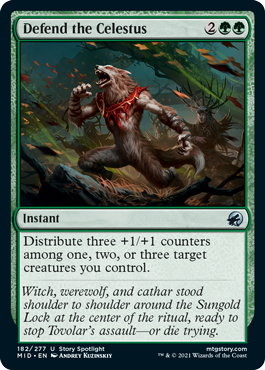
Defend the Celestus
{2}{G}{G}
Instant
Distribute three +1/+1 counters among one, two, or three target creatures you control.
- You decide how to distribute the counters as you cast Defend the Celestus. You must distribute at least one counter to each creature you target.
- If some, but not all, of the target creatures are illegal targets as Defend the Celestus resolves, the original distribution of counters remains the same. Counters that were to be put on the now-illegal targets are lost.
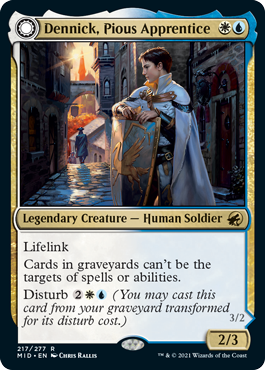
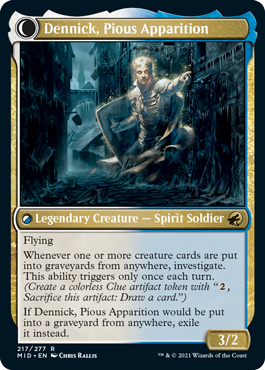
Dennick, Pious Apprentice
{W}{U}
Legendary Creature — Human Soldier
2/3
Lifelink
Cards in graveyards can’t be the targets of spells or abilities.
Disturb {2}{W}{U} (You may cast this card from your graveyard transformed for its disturb cost.)
////
Dennick, Pious Apparition
Legendary Creature — Spirit Soldier
3/2
Flying
Whenever one or more creature cards are put into graveyards from anywhere, investigate. This ability triggers only once each turn. (To investigate, create a colorless Clue artifact token with “{2}, Sacrifice this artifact: Draw a card.”)
If Dennick, Pious Apparition would be put into a graveyard from anywhere, exile it instead.
- The second ability of Dennick, Pious Apprentice (front face) affects only spells and abilities that actually target cards in graveyards. Spells and abilities that affect cards in graveyards without targeting them may still affect them, move them to other zones, and so on.
- The triggered ability of Dennick, Pious Apparition (back face) looks at what type the cards are after they move to the graveyard to determine whether the ability should trigger, regardless of any types they may have had before they were in the graveyard. For example, a creature card that has become a noncreature permanent, perhaps because it was enchanted by Minimus Containment, will cause the ability to trigger when it’s put into a graveyard. By contrast, a noncreature card that has become a creature on the battlefield will not cause the ability to trigger when it’s put into a graveyard.
- A token dying will never cause the triggered ability to trigger because a token is not a card.
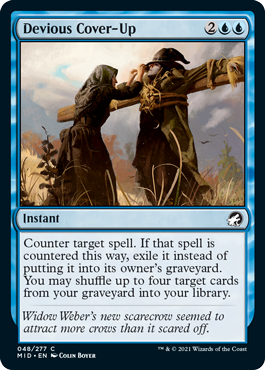
Devious Cover-Up
{2}{U}{U}
Instant
Counter target spell. If that spell is countered this way, exile it instead of putting it into its owner’s graveyard. You may shuffle up to four target cards from your graveyard into your library.
- Devious Cover-Up can’t target itself at all. You can’t try to counter it with itself and shuffle cards in, and you can’t use its effect to shuffle itself into your library.
- A spell that can’t be countered is a legal target for Devious Cover-Up. The spell won’t be countered when Devious Cover-Up resolves, but you’ll still shuffle cards into your library.
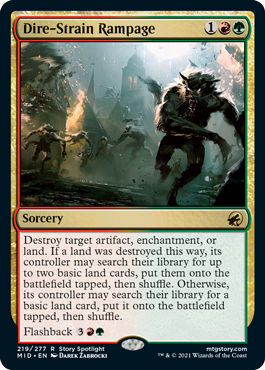
Dire-Strain Rampage
{1}{R}{G}
Sorcery
Destroy target artifact, enchantment, or land. If a land was destroyed this way, its controller may search their library for up to two basic land cards, put them onto the battlefield tapped, then shuffle. Otherwise, its controller may search their library for a basic land card, put it onto the battlefield tapped, then shuffle.
Flashback {3}{R}{G}
- If the target permanent became an illegal target by the time Dire-Strain Rampage tried to resolve, the spell won’t resolve and none of its effects will happen. No player will search their library for any cards. However, if the target is still legal but wasn’t destroyed, perhaps because it was indestructible, its controller may still search their library for a basic land card (even if the target was a land).
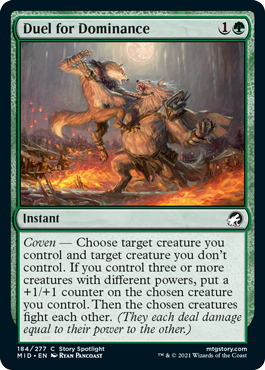
Duel for Dominance
{1}{G}
Instant
Coven — Choose target creature you control and target creature you don’t control. If you control three or more creatures with different powers, put a +1/+1 counter on the chosen creature you control. Then the chosen creatures fight each other. (They each deal damage equal to their power to the other.)
- Only the +1/+1 counter is contingent on having three or more creatures with different powers. The target creatures will still fight even if you don’t have three or more creatures with different powers when Duel for Dominance resolves.
- If you control three or more creatures with different powers and the target creature you control is still a legal target as Duel for Dominance resolves but the target creature you don’t control isn’t, you will still put a +1/+1 counter on the creature you control. It isn’t much of a duel, but your creature is still dominant.
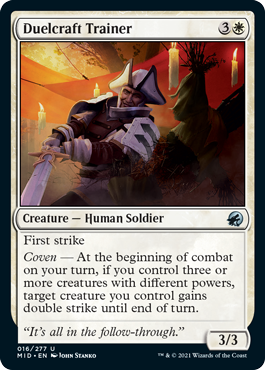
Duelcraft Trainer
{3}{W}
Creature — Human Soldier
3/3
First strike
Coven — At the beginning of combat on your turn, if you control three or more creatures with different powers, target creature you control gains double strike until end of turn.
- Duelcraft Trainer’s triggered ability checks to see if you have three or more creatures with different powers both when it triggers and as it tries to resolve. If you don’t have three creatures with different powers as it tries to resolve, it will be removed from the stack.
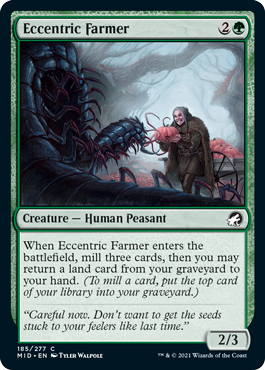
Eccentric Farmer
{2}{G}
Creature — Human Peasant
2/3
When Eccentric Farmer enters the battlefield, mill three cards, then you may return a land card from your graveyard to your hand. (To mill a card, put the top card of your library into your graveyard.)
- You don’t have to choose the land card you will return to your hand until after you have milled three cards.
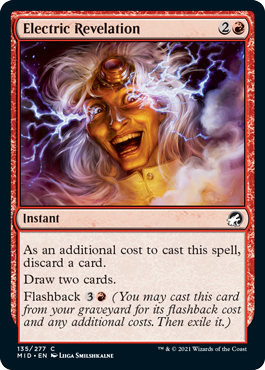
Electric Revelation
{2}{R}
Instant
As an additional cost to cast this spell, discard a card.
Draw two cards.
Flashback {3}{R} (You may cast this card from your graveyard for its flashback cost and any additional costs. Then exile it.)
- If you cast Electric Revelation using flashback, you must still pay its additional cost of discarding a card.
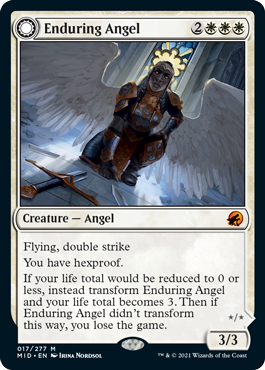
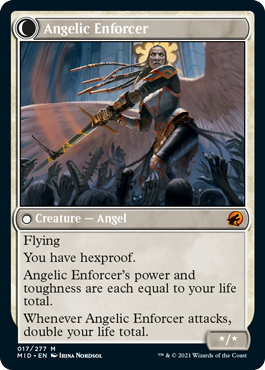
Enduring Angel
{2}{W}{W}{W}
Creature — Angel
3/3
Flying, double strike
You have hexproof.
If your life total would be reduced to 0 or less, instead transform Enduring Angel and your life total becomes 3. Then if Enduring Angel didn’t transform this way, you lose the game.
////
Angelic Enforcer
Creature — Angel
*/*
Flying
You have hexproof.
Angelic Enforcer’s power and toughness are each equal to your life total.
Whenever Angelic Enforcer attacks, double your life total.
- Enduring Angel’s last ability is a replacement effect. It doesn’t use the stack and can’t be responded to. Notably, players cannot try to destroy Enduring Angel to prevent it from transforming and cause you to lose the game. Applying the replacement effect can’t cause Enduring Angel to transform if it isn’t a double-faced permanent; that is, if it’s a token or if a single-faced permanent has become a copy of it. In that situation, you will lose the game.
- To double a player’s life total, that player gains an amount of life such that their new life total is twice its current value. (In some very unusual cases, a player may have a negative life total and will still be in the game. In those cases, the player will lose an amount of life such that their new life total is twice its current value.)
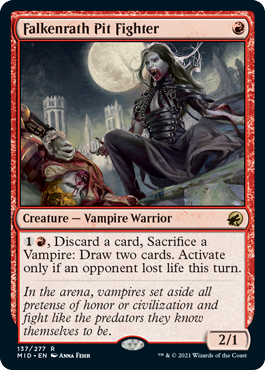
Falkenrath Pit Fighter
{R}
Creature — Vampire Warrior
2/1
{1}{R}, Discard a card, Sacrifice a Vampire: Draw two cards. Activate only if an opponent lost life this turn.
- Falkenrath Pit Fighter’s ability can be activated if any opponent lost any amount of life this turn, even if they also gained life at some point.
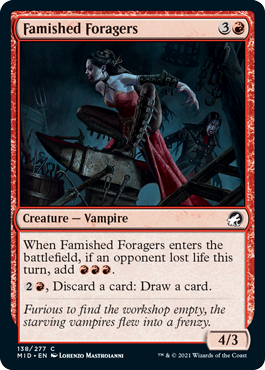
Famished Foragers
{3}{R}
Creature — Vampire
4/3
When Famished Foragers enters the battlefield, if an opponent lost life this turn, add {R}{R}{R}.
{2}{R}, Discard a card: Draw a card.
- The triggered ability adds {R}{R}{R} if any opponent lost any amount of life this turn, even if they also gained life at some point.
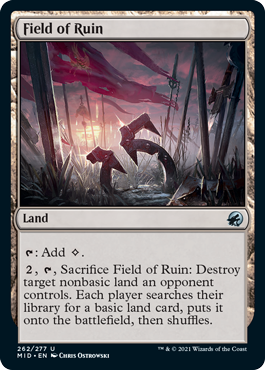
Field of Ruin
Land
{T}: Add {C}.
{2}, {T}, Sacrifice Field of Ruin: Destroy target nonbasic land an opponent controls. Each player searches their library for a basic land card, puts it onto the battlefield, then shuffles.
- If the target land is an illegal target by the time Field of Ruin’s ability tries to resolve, the ability doesn’t resolve. No players search for a basic land card or shuffle. If the target is legal but not destroyed (most likely because it has indestructible), each player does search and shuffle.
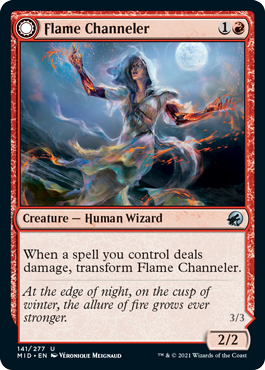
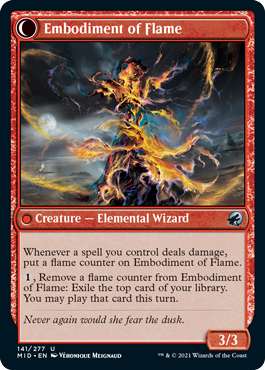
Flame Channeler
{1}{R}
Creature — Human Wizard
2/2
When a spell you control deals damage, transform Flame Channeler.
////
Embodiment of Flame
Creature — Elemental Wizard
3/3
Whenever a spell you control deals damage, put a flame counter on Embodiment of Flame.
{1}, Remove a flame counter from Embodiment of Flame: Exile the top card of your library. You may play that card this turn.
- “A spell you control” means a spell on the stack. Usually, spells on the stack can deal damage only as part of their own resolution.
- Some spells cause other objects to deal damage, such as spells that have two creatures fight. In those cases, it’s those other objects that are dealing damage, not the spell itself, and this will not cause Flame Channeler or Embodiment of Flame’s abilities to trigger.
- A spell that becomes a permanent and then deals damage, such as one that has a triggered ability when it enters the battlefield, will not cause Flame Channeler or Embodiment of Flame’s abilities to trigger.
- You must pay all costs and follow all timing rules for cards you play with Embodiment of Flame’s activated ability.
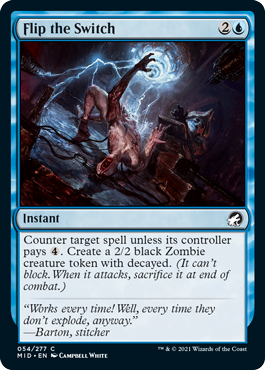
Flip the Switch
{2}{U}
Instant
Counter target spell unless its controller pays {4}. Create a 2/2 black Zombie creature token with decayed. (It can’t block. When it attacks, sacrifice it at end of combat.)
- You will create a Zombie creature token even if the spell’s controller pays {4}.
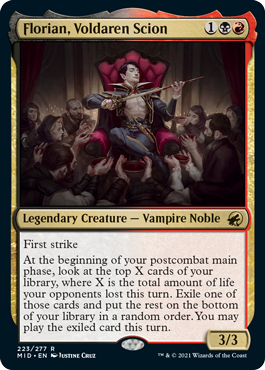
Florian, Voldaren Scion
{1}{B}{R}
Legendary Creature — Vampire Noble
3/3
First strike
At the beginning of your postcombat main phase, look at the top X cards of your library, where X is the total amount of life your opponents lost this turn. Exile one of those cards and put the rest on the bottom of your library in a random order. You may play the exiled card this turn.
- Damage dealt to a player causes that player to lose that much life.
- You get a postcombat main phase even if no creatures attacked during a turn. Florian’s last ability will trigger.
- If an opponent loses life but Florian leaves the battlefield before your postcombat main phase begins, its last ability doesn’t trigger.
- Florian’s ability checks only how much life opponents lost during the turn, not by how much their life totals decreased compared to the start of the turn. For example, if an opponent lost 2 life and then gained 8 life before Florian’s ability resolves, you’ll look at the top two cards of your library.
- If an opponent loses life and subsequently loses the game before your postcombat main phase, Florian’s last ability counts that loss of life.
- If you somehow have more than two main phases in a turn, each main phase after your first one is a postcombat main phase, and Florian’s last ability triggers at the beginning of each of them.
- You must pay all costs and follow all timing rules for cards you play with Florian’s last ability.

Galvanic Iteration
{U}{R}
Instant
When you cast your next instant or sorcery spell this turn, copy that spell. You may choose new targets for the copy.
Flashback {1}{U}{R} (You may cast this card from your graveyard for its flashback cost. Then exile it.)
- If you resolve one Galvanic Iteration after another (or cast the same one with flashback), the second Galvanic Iteration will be copied. That copy and spell each resolve, creating two delayed triggered abilities. The next spell you cast after that will be copied twice. If that spell is also a Galvanic Iteration, the following spell will be copied three times, and so on.
- Galvanic Iteration’s ability will copy any instant or sorcery spell, not just one with targets.
- A copy is created even if the spell that caused Galvanic Iteration’s ability to trigger has been countered by the time that ability resolves. The copy resolves before the original spell.
- The copy will have the same targets as the spell it’s copying unless you choose new ones. You may change any number of the targets, including all of them or none of them. The new targets must be legal.
- If the spell that’s copied is modal (that is, it says “Choose one —” or the like), the copy will have the same mode or modes. You can’t choose different ones.
- If the spell that’s copied has an X whose value was determined as it was cast, the copy has the same value of X.
- You can’t choose to pay any additional costs for the copy. However, effects based on any additional costs that were paid for the original spell are copied as though those same costs were paid for the copy too.
- The copy that Galvanic Iteration’s ability creates is created on the stack, so it’s not “cast.” Abilities that trigger when a player casts a spell won’t trigger.
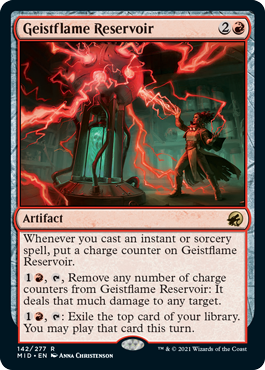
Geistflame Reservoir
{2}{R}
Artifact
Whenever you cast an instant or sorcery spell, put a charge counter on Geistflame Reservoir.
{1}{R}, {T}, Remove any number of charge counters from Geistflame Reservoir: It deals that much damage to any target.
{1}{R}, {T}: Exile the top card of your library. You may play that card this turn.
- You choose how many counters to remove from Geistflame Reservoir as you activate its second ability, not as it resolves.
- You must still pay all costs and follow all timing rules to play a card exiled with Geistflame Reservoir’s last ability.
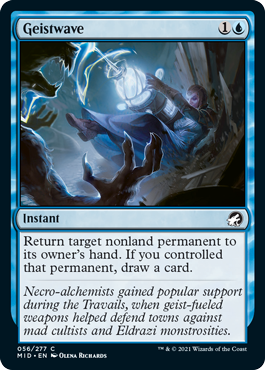
Geistwave
{1}{U}
Instant
Return target nonland permanent to its owner’s hand. If you controlled that permanent, draw a card.
- You won’t draw a card if you don’t control the target permanent as Geistwave resolves, even if you controlled that permanent at some previous point.
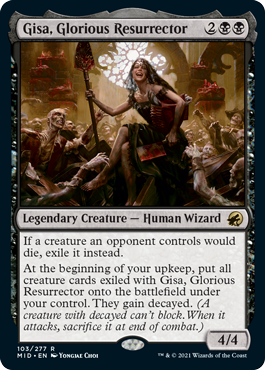
Gisa, Glorious Resurrector
{2}{B}{B}
Legendary Creature — Human Wizard
4/4
If a creature an opponent controls would die, exile it instead.
At the beginning of your upkeep, put all creature cards exiled with Gisa, Glorious Resurrector onto the battlefield under your control. They gain decayed. (A creature with decayed can’t block. When it attacks, sacrifice it at end of combat.)
- Because creatures controlled by opponents aren’t dying due to Gisa’s replacement effect, any “when [this creature] dies” triggered abilities those creatures have won’t trigger.
- Gisa does not grant haste to the creatures that are returned to the battlefield, so you normally won’t be able to attack with them the turn they are returned.
- If a creature your opponent controls would die and more than one effect would cause it to be exiled, that opponent chooses which one to apply. If the creature is exiled due to some other replacement effect, it will not be returned to the battlefield with Gisa.
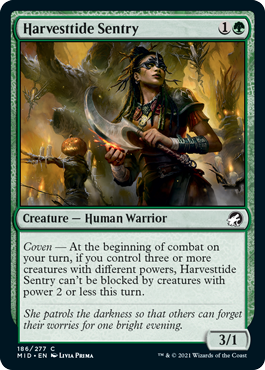
Harvesttide Sentry
{1}{G}
Creature — Human Warrior
3/1
Coven — At the beginning of combat on your turn, if you control three or more creatures with different powers, Harvesttide Sentry can’t be blocked by creatures with power 2 or less this turn.
- Harvesttide Sentry’s triggered ability checks your creatures’ powers both when it triggers and as it tries to resolve. If you somehow don’t have enough creatures with different powers as it tries to resolve, nothing happens and Harvesttide Sentry can be blocked as normal.
- Once its ability resolves, removing one of the creatures with different powers won’t allow a player to block Harvesttide Sentry with creatures with power 2 or less.
- The blocking restriction is applied only when blockers are declared. After the coven ability resolves, if a player blocks Harvesttide Sentry with a creature with power greater than 2, reducing that creature’s power won’t make Harvesttide Sentry unblocked.
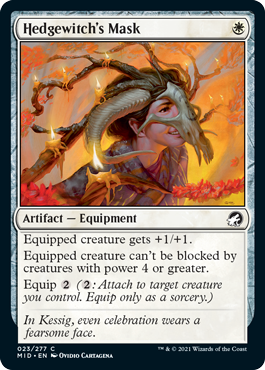
Hedgewitch’s Mask
{W}
Artifact — Equipment
Equipped creature gets +1/+1.
Equipped creature can’t be blocked by creatures with power 4 or greater.
Equip {2} ({2}: Attach to target creature you control. Equip only as a sorcery.)
- The blocking restriction is applied only when blockers are declared. Once a creature equipped with Hedgewitch’s Mask becomes blocked by a creature with power less than 4, increasing that creature’s power won’t cause the equipped creature to become unblocked.
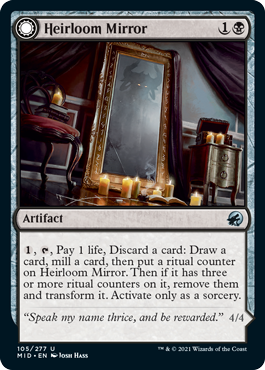
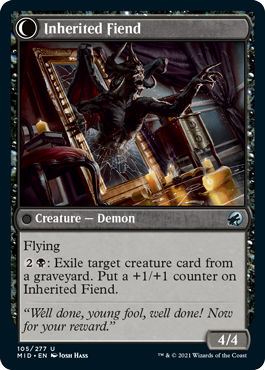
Heirloom Mirror
{1}{B}
Artifact
{1}, {T}, Pay 1 life, Discard a card: Draw a card, mill a card, then put a ritual counter on Heirloom Mirror. Then if it has three or more ritual counters on it, remove them and transform it. Activate only as a sorcery.
////
Inherited Fiend
Creature — Demon
4/4
Flying
{2}{B}: Exile target creature card from a graveyard. Put a +1/+1 counter on Inherited Fiend.
- Heirloom Mirror will still be tapped after it transforms into Inherited Fiend unless some other effect has untapped it.
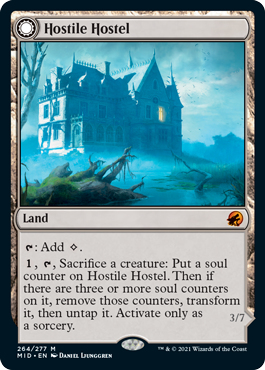
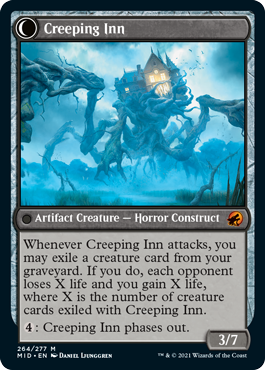
Hostile Hostel
Land
{T}: Add {C}.
{1}, {T}, Sacrifice a creature: Put a soul counter on Hostile Hostel. Then if there are three or more soul counters on it, remove those counters, transform it, then untap it. Activate only as a sorcery.
////
Creeping Inn
Artifact Creature — Horror Construct
3/7
Whenever Creeping Inn attacks, you may exile a creature card from your graveyard. If you do, each opponent loses X life and you gain X life, where X is the number of creature cards exiled with Creeping Inn.
{4}: Creeping Inn phases out.
- While Creeping Inn is phased out, it’s treated as though it doesn’t exist. It can’t be the target of spells or abilities, its static abilities have no effect on the game, its triggered abilities can’t trigger, it can’t attack or block, and so on.
- If Creeping Inn is attacking or blocking when it phases out, it is removed from combat.
- Phasing out doesn’t cause any “leaves the battlefield” abilities to trigger. Similarly, phasing in won’t cause any “enters the battlefield” abilities to trigger.
- Creeping Inn will phase in during its controller’s untap step. It will be able to attack the same turn.
- When Creeping Inn phases in, it still remembers what cards were previously exiled with it.
- Phasing out or phasing in doesn’t affect which face of a double-faced card is face up.
- Each Aura and Equipment attached to a permanent that’s phasing out also phases out. They will phase in with that permanent and still be attached to it. Similarly, permanents that phase out with counters phase in with those counters.
- If an opponent gains control of Creeping Inn and it phases out and the duration of the control-change effect expires before it phases in, it phases in under your control as that opponent’s appropriate untap step begins. If they leave the game before that untap step, it phases in as the next untap step begins after that turn would have begun.
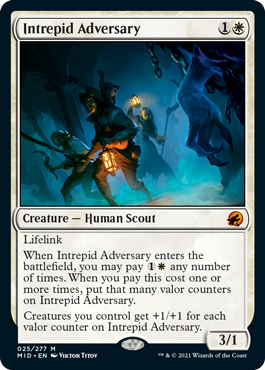
Intrepid Adversary
{1}{W}
Creature — Human Scout
3/1
Lifelink
When Intrepid Adversary enters the battlefield, you may pay {1}{W} any number of times. When you pay this cost one or more times, put that many valor counters on Intrepid Adversary.
Creatures you control get +1/+1 for each valor counter on Intrepid Adversary.
- After you pay the {1}{W} cost one or more times, a second ability triggers and players may respond to it. As that ability resolves, the Intrepid Adversary gets its valor counters.
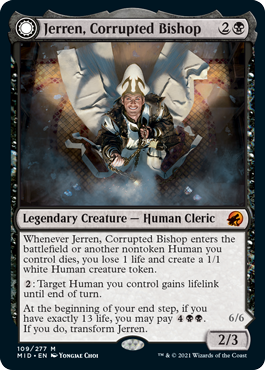
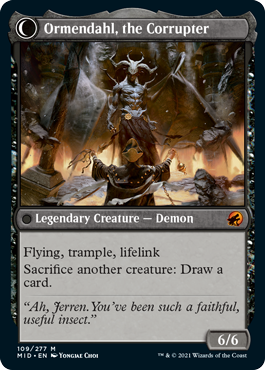
Jerren, Corrupted Bishop
{2}{B}
Legendary Creature — Human Cleric
2/3
Whenever Jerren, Corrupted Bishop enters the battlefield or another nontoken Human you control dies, you lose 1 life and create a 1/1 white Human creature token.
{2}: Target Human you control gains lifelink until end of turn.
At the beginning of your end step, if you have exactly 13 life, you may pay {4}{B}{B}. If you do, transform Jerren.
////
Ormendahl, the Corrupter
Legendary Creature — Demon
6/6
Flying, trample, lifelink
Sacrifice another creature: Draw a card.
- Multiple instances of lifelink are redundant, so giving lifelink to a Human that already has it gives no additional benefit.
- Jerren’s last ability will trigger only if you have exactly 13 life at the beginning of your end step. You will be able to pay {4}{B}{B} only if you have exactly 13 life as that ability begins to resolve. If your life total isn’t 13 at that point, the ability will have no effect. You won’t be able to pay {4}{B}{B} and Jerren won’t transform.
- If, while activating mana abilities during the resolution of Jerren’s last ability, you somehow gain or lose life, you will still be able to finish paying the cost and Jerren will still transform.
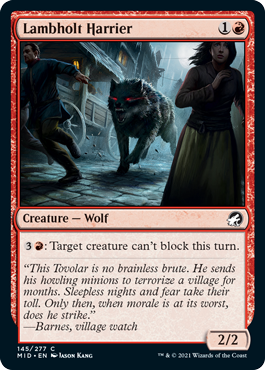
Lambholt Harrier
{1}{R}
Creature — Wolf
2/2
{3}{R}: Target creature can’t block this turn.
- Lambholt Harrier’s ability must be activated before blockers are declared to have any effect. Activating it after a creature has been declared as a blocker will not remove that creature from combat.
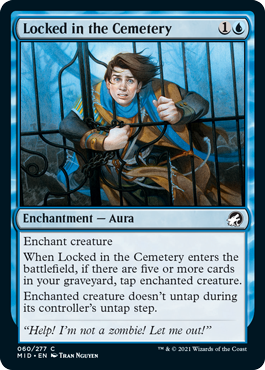
Locked in the Cemetery
{1}{U}
Enchantment — Aura
Enchant creature
When Locked in the Cemetery enters the battlefield, if there are five or more cards in your graveyard, tap enchanted creature.
Enchanted creature doesn’t untap during its controller’s untap step.
- The enchanted creature can still be untapped in other ways. Locked in the Cemetery will remain attached, and the creature will continue to not untap during its controller’s untap step.

Loyal Gryff
{2}{W}
Creature — Hippogriff
2/2
Flash
Flying
When Loyal Gryff enters the battlefield, you may return another creature you control to its owner’s hand.
- You choose whether to return a creature to your hand and which creature to return as Loyal Gryff’s triggered ability resolves.
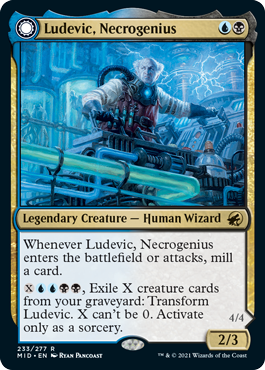
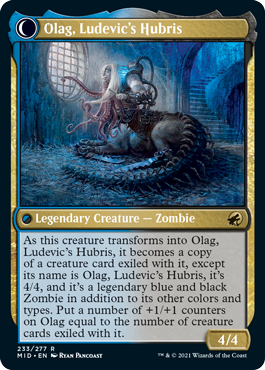
Ludevic, Necrogenius
{U}{B}
Legendary Creature — Human Wizard
2/3
Whenever Ludevic, Necrogenius enters the battlefield or attacks, mill a card.
{X}{U}{U}{B}{B}, Exile X creature cards from your graveyard: Transform Ludevic. X can’t be 0. Activate only as a sorcery.
////
Olag, Ludevic’s Hubris
Legendary Creature — Zombie
4/4
As this creature transforms into Olag, Ludevic’s Hubris, it becomes a copy of a creature card exiled with it, except its name is Olag, Ludevic’s Hubris, it’s 4/4, and it’s a legendary blue and black Zombie in addition to its other colors and types. Put a number of +1/+1 counters on Olag equal to the number of creature cards exiled with it.
- You choose which exiled creature card Olag is copying as it transforms. It doesn’t transform and then become a copy.
- Olag remains a copy of the creature card you choose even if that card later leaves exile.
- It’s possible for Olag to become a copy of a card with the daybound keyword ability as it transforms. If this happens, it doesn’t transform as it becomes night.
- If there are no creature cards exiled with Ludevic as it transforms, perhaps because those cards were removed from exile in response to its activated ability or it transformed another way, Olag won’t be a copy of anything. Olag will simply be its 4/4 self with no +1/+1 counters.
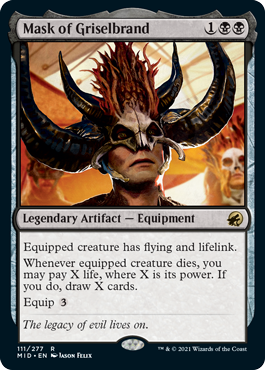
Mask of Griselbrand
{1}{B}{B}
Legendary Artifact — Equipment
Equipped creature has flying and lifelink.
Whenever equipped creature dies, you may pay X life, where X is its power. If you do, draw X cards.
Equip {3}
- Use the equipped creature’s power as it last existed on the battlefield to determine the value of X.
- You must pay exactly X life or nothing. You can’t pay less life to draw fewer cards.
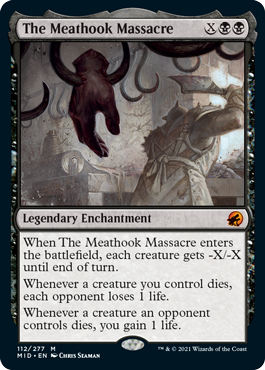
The Meathook Massacre
{X}{B}{B}
Legendary Enchantment
When The Meathook Massacre enters the battlefield, each creature gets -X/-X until end of turn.
Whenever a creature you control dies, each opponent loses 1 life.
Whenever a creature an opponent controls dies, you gain 1 life.
- If The Meathook Massacre enters the battlefield and it wasn’t cast (or it was cast without paying its mana cost), X will be 0. The first ability will trigger, but it won’t be much of a massacre.
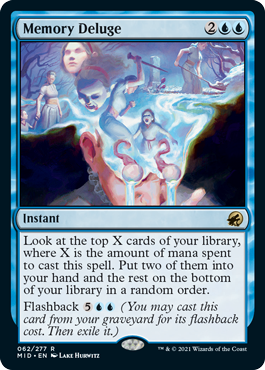
Memory Deluge
{2}{U}{U}
Instant
Look at the top X cards of your library, where X is the amount of mana spent to cast this spell. Put two of them into your hand and the rest on the bottom of your library in a random order.
Flashback {5}{U}{U} (You may cast this card from your graveyard for its flashback cost. Then exile it.)
- Memory Deluge cares about the mana you actually paid to cast it, not its mana cost. If you cast Memory Deluge for {2}{U}{U}, you will look at four cards. If you cast it with flashback for {5}{U}{U}, you will look at seven cards. Any effects that increase or decrease the cost to cast it will also be taken into account.
- If Memory Deluge is copied, no mana was spent to cast the copy, so X will be 0. The amount of mana spent to cast the original spell is not copied. You won’t look at any cards from your library as Memory Deluge resolves.
- If an effect allows you to cast Memory Deluge without paying its mana cost, X will be 0. Memory Deluge will resolve, but you won’t do anything.
- If an effect requires you to pay some amount of mana to prevent Memory Deluge from being countered, as Flip the Switch does, that mana wasn’t spent to cast Memory Deluge and will not be taken into account.
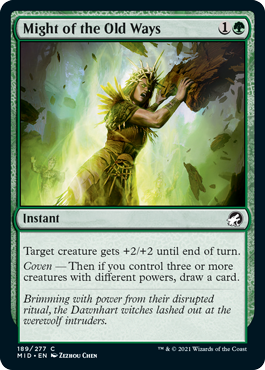
Might of the Old Ways
{1}{G}
Instant
Target creature gets +2/+2 until end of turn.
Coven — Then if you control three or more creatures with different powers, draw a card.
- The effects of Might of the Old Ways happen in the listed order, so the +2/+2 bonus happens before you check the powers of creatures you control. For example, if you control two 2/2 creatures and a 5/5 creatures, choosing one of the 2/2 creatures as the target will allow you to draw a card. Conversely, if you control a 1/1 creature, a 3/3 creature, and a 5/5 creature, targeting either of the two smaller creatures will not allow you to draw a card.
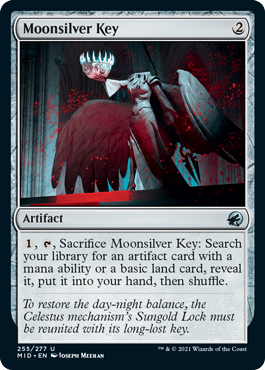
Moonsilver Key
{2}
Artifact
{1}, {T}, Sacrifice Moonsilver Key: Search your library for an artifact card with a mana ability or a basic land card, reveal it, put it into your hand, then shuffle.
- Most mana abilities found on artifacts are activated mana abilities. An activated mana ability is an activated ability that could produce mana as it resolves, does not require a target, and isn’t a loyalty ability.
- Some artifacts, such as Gauntlet of Power, have triggered mana abilities. A triggered mana ability is a triggered ability that could produce mana as it resolves, triggers on the resolution of an activated mana ability or on mana being added, and doesn’t require a target.
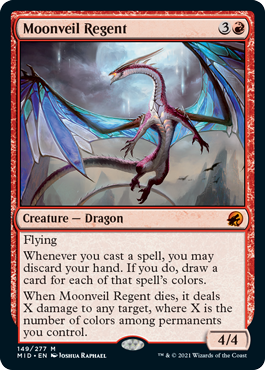
Moonveil Regent
{3}{R}
Creature — Dragon
4/4
Flying
Whenever you cast a spell, you may discard your hand. If you do, draw a card for each of that spell’s colors.
When Moonveil Regent dies, it deals X damage to any target, where X is the number of colors among permanents you control.
- If you have no cards in hand as Moonveil Regent’s first ability resolves, you may still choose to discard your hand. You’ll just draw a card for each of that spell’s colors. Great plan!
- If you cast a colorless spell, you may choose to discard your hand and draw no cards. Less great plan?
- The colors of a transforming double-faced card that was cast with the disturb keyword ability are determined by its color indicator, not the mana cost on the front face of the card.
- Moonveil Regent’s last ability triggers even if you control no permanents that are one or more colors when it dies. The amount of damage is calculated as the ability resolves. Consider only the permanents you control at that time to determine how much damage Moonveil Regent deals.
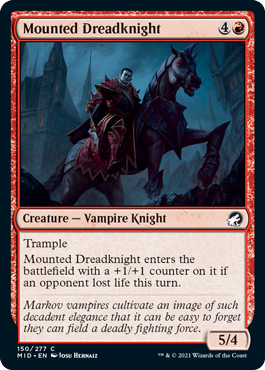
Mounted Dreadknight
{4}{R}
Creature — Vampire Knight
5/4
Trample
Mounted Dreadknight enters the battlefield with a +1/+1 counter on it if an opponent lost life this turn.
- Mounted Dreadknight’s last ability cares whether an opponent lost life this turn, not how their life total changed. For example, an opponent who gained 2 life and lost 1 life in the same turn still lost life.
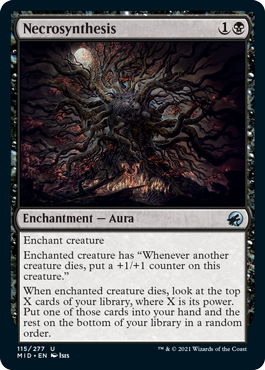
Necrosynthesis
{1}{B}
Enchantment — Aura
Enchant creature
Enchanted creature has “Whenever another creature dies, put a +1/+1 counter on this creature.”
When enchanted creature dies, look at the top X cards of your library, where X is its power. Put one of those cards into your hand and the rest on the bottom of your library in a random order.
- Use the enchanted creature’s power as it last existed on the battlefield to determine the value of X.
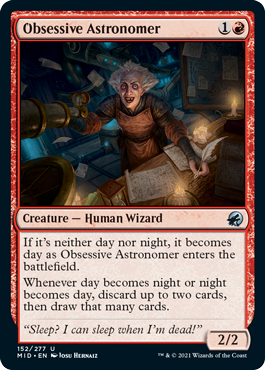
Obsessive Astronomer
{1}{R}
Creature — Human Wizard
2/2
If it’s neither day nor night, it becomes day as Obsessive Astronomer enters the battlefield.
Whenever day becomes night or night becomes day, discard up to two cards, then draw that many cards.
- You may choose to discard no cards when the Obsessive Astronomer’s triggered ability resolves.
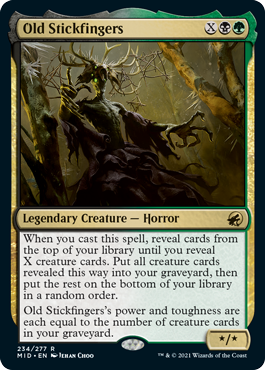
Old Stickfingers
{X}{B}{G}
Legendary Creature — Horror
*/*
When you cast this spell, reveal cards from the top of your library until you reveal X creature cards. Put all creature cards revealed this way into your graveyard, then put the rest on the bottom of your library in a random order.
Old Stickfingers’s power and toughness are each equal to the number of creature cards in your graveyard.
- The triggered ability will resolve before Old Stickfingers does. If Old Stickfingers is countered in response to its own triggered ability, you will still follow all the instructions of the triggered ability, using the chosen value of X.
- The ability that defines the power and toughness of Old Stickfingers functions in all zones, not only while Old Stickfingers is on the battlefield. While Old Stickfingers is in a graveyard, the ability will count Old Stickfingers itself, presumably using a single, withered stickfinger.
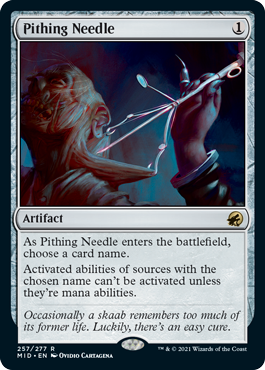
Pithing Needle
{1}
Artifact
As Pithing Needle enters the battlefield, choose a card name.
Activated abilities of sources with the chosen name can’t be activated unless they’re mana abilities.
- Activated abilities include a colon and are written in the form “[cost]: [effect].” Triggered abilities and static abilities of the named card work normally.
- Pithing Needle affects cards regardless of what zone they’re in. This includes cards in hand, cards in the graveyard, and exiled cards. For example, a player can’t cycle a card with the chosen name.
- Pithing Needle doesn’t stop a player from casting spells. Notable, choosing a card name with flashback or disturb doesn’t stop a player from casting those spells from their graveyard.
- You can choose any existing card name, even if that card doesn’t normally have an activated ability. You can’t name a token unless that token has the same name as a card.
- If you name a card that has both a mana ability and another activated ability, the mana ability can be activated but the other ability can’t be activated.
- You can name either face of a double-faced card, but not both. Pithing Needle affects objects only while they have the chosen name.
- Once Pithing Needle has left the battlefield, activated abilities of sources with the chosen name can be activated again.
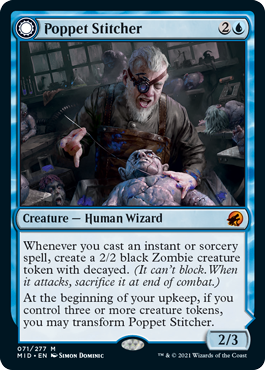
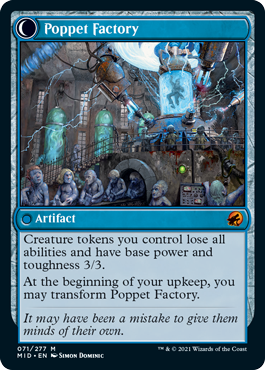
Poppet Stitcher
{2}{U}
Creature — Human Wizard
2/3
Whenever you cast an instant or sorcery spell, create a 2/2 black Zombie creature token with decayed. (It can’t block. When it attacks, sacrifice it at end of combat.)
At the beginning of your upkeep, if you control three or more creature tokens, you may transform Poppet Stitcher.
////
Poppet Factory
Artifact
Creature tokens you control lose all abilities and have base power and toughness 3/3.
At the beginning of your upkeep, you may transform Poppet Factory.
- Poppet Factory’s first ability removes all abilities from creature tokens you control, including ones they were created with and ones they gained since the last time Poppet Factory transformed.
- As Poppet Factory transforms back into Poppet Stitcher, the effect making your creature tokens 3/3 and making them lose their abilities ends. Their base powers and toughnesses will revert to whatever they were before that effect started applying, although other effects that modify power and/or toughness, such as ones created by Auras, counters, and the like may still apply. They’ll also have whatever abilities they had before they lost them.
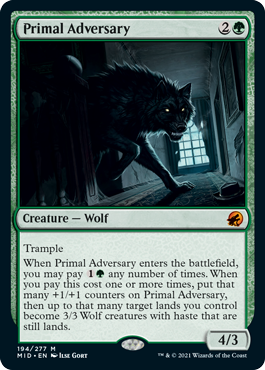
Primal Adversary
{2}{G}
Creature — Wolf
4/3
Trample
When Primal Adversary enters the battlefield, you may pay {1}{G} any number of times. When you pay this cost one or more times, put that many +1/+1 counters on Primal Adversary, then up to that many target lands you control become 3/3 Wolf creatures with haste that are still lands.
- After you pay the {1}{G} cost one or more times, a second ability triggers and you choose the targets for it. Players may respond to the new ability at that point. As that ability resolves, Primal Adversary gets its +1/+1 counters and the target lands become Wolf creatures.
- Any land that becomes a Wolf creature this way will retain any supertypes, card types, subtypes, and abilities it had.
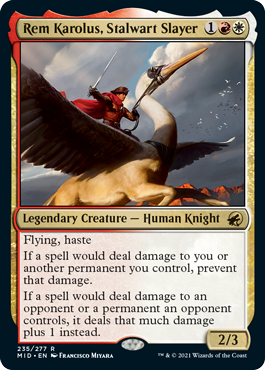
Rem Karolus, Stalwart Slayer
{1}{R}{W}
Legendary Creature — Human Knight
2/3
Flying, haste
If a spell would deal damage to you or another permanent you control, prevent that damage.
If a spell would deal damage to an opponent or a permanent an opponent controls, it deals that much damage plus 1 instead.
- Rem Karolus, Stalwart Slayer’s last two abilities apply only to damage dealt by spells on the stack. A spell that becomes a permanent and then deals damage won’t be affected.
- Some spells cause other objects to deal damage, such as spells that cause two creatures to fight. Rem Karolus, Stalwart Slayer’s last two abilities don’t apply to damage from such effects.
- The additional 1 damage is dealt by the original source of damage. The additional damage isn’t dealt by Rem Karolus.
- If another effect modifies how much damage a spell would deal to an opponent or a permanent they control, including preventing some of it, the player being dealt damage or the controller of the permanent being dealt damage chooses an order in which to apply those effects. If all of the damage is prevented, Rem’s effect no longer applies.
- If damage dealt by a source you control is being divided or assigned among multiple permanents an opponent controls or among an opponent and one or more permanents they control, divide the original amount before adding 1. For example, if you cast a spell that deals 4 damage divided among any number of targets and you choose to have it deal 2 damage to a creature and 2 damage to that creature’s controller, that spell will deal 3 damage to each of them instead.
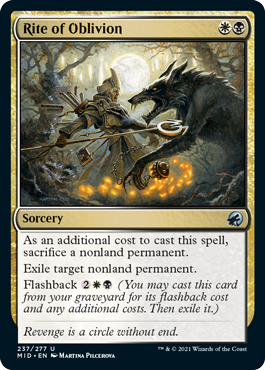
Rite of Oblivion
{W}{B}
Sorcery
As an additional cost to cast this spell, sacrifice a nonland permanent.
Exile target nonland permanent.
Flashback {2}{W}{B} (You may cast this card from your graveyard for its flashback cost and any additional costs. Then exile it.)
- If you cast Rite of Oblivion using flashback, you must still pay its additional cost of sacrificing a nonland permanent.
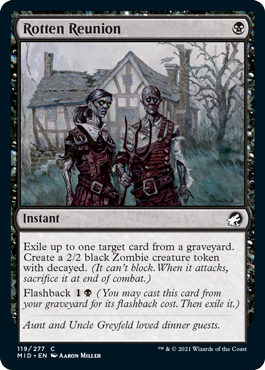
Rotten Reunion
{B}
Instant
Exile up to one target card from a graveyard. Create a 2/2 black Zombie creature token with decayed. (It can’t block. When it attacks, sacrifice it at end of combat.)
Flashback {1}{B} (You may cast this card from your graveyard for its flashback cost. Then exile it.)
- You don’t have to choose any targets for Rotten Reunion. However, if you do, and that target is illegal as Rotten Reunion tries to resolve (perhaps because your opponent responded with their own Rotten Reunion), it will be removed from the stack and you won’t create a Zombie token.
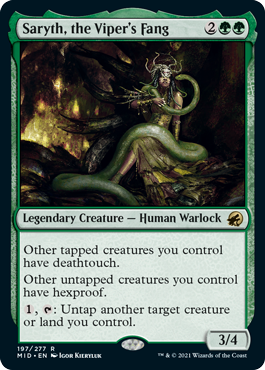
Saryth, the Viper’s Fang
{2}{G}{G}
Legendary Creature — Human Warlock
3/4
Other tapped creatures you control have deathtouch.
Other untapped creatures you control have hexproof.
{1}, {T}: Untap another target creature or land you control.
- Saryth’s first ability doesn’t care whether Saryth is tapped or untapped. The same is true for the second ability. Both abilities apply as long as Saryth is on the battlefield.
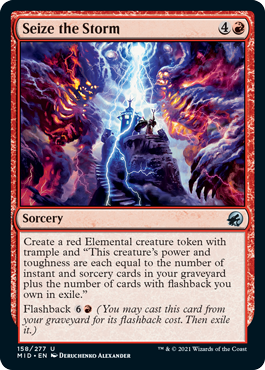
Seize the Storm
{4}{R}
Sorcery
Create a red Elemental creature token with trample and “This creature’s power and toughness are each equal to the number of instant and sorcery cards in your graveyard plus the number of cards with flashback you own in exile.”
Flashback {6}{R} (You may cast this card from your graveyard for its flashback cost. Then exile it.)
- The power and toughness of the Elemental token will change as the number of instant and sorcery cards in your graveyard and the number of cards with flashback you own in exile change.
- If you cast Seize the Storm with no instant or sorcery cards in your graveyard and no cards with flashback in exile, the Elemental will start as a 0/0 creature. However, state-based actions won’t be checked until after Seize the Storm has finished resolving. The Elemental will then be a 1/1 creature and survive because Seize the Storm will either be in your graveyard or in exile.
- While a spell is on the stack, it is neither in your graveyard nor in exile, so it won’t contribute to the Elemental’s power and toughness. For example, with Seize the Storm in your graveyard and no cards in exile, the 1/1 Elemental in the above scenario will become 0/0 and die if you cast Seize the Storm from your graveyard using flashback.
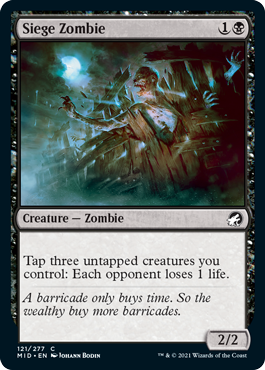
Siege Zombie
{1}{B}
Creature — Zombie
2/2
Tap three untapped creatures you control: Each opponent loses 1 life.
- Since Siege Zombie’s activated ability doesn’t have a tap symbol in its cost, you can tap creatures that haven’t been under your control since your most recent turn began (including Siege Zombie itself) to pay the cost.
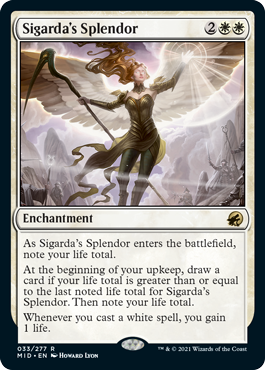
Sigarda’s Splendor
{2}{W}{W}
Enchantment
As Sigarda’s Splendor enters the battlefield, note your life total.
At the beginning of your upkeep, draw a card if your life total is greater than or equal to the last noted life total for Sigarda’s Splendor. Then note your life total.
Whenever you cast a white spell, you gain 1 life.
- You will note your life total as the second ability resolves, even if you don’t draw a card.
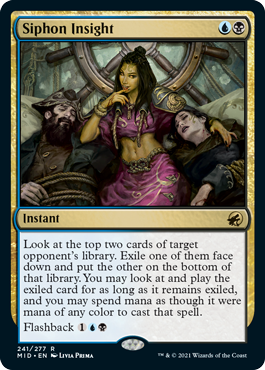
Siphon Insight
{U}{B}
Instant
Look at the top two cards of target opponent’s library. Exile one of them face down and put the other on the bottom of that library. You may look at and play the exiled card for as long as it remains exiled, and you may spend mana as though it were mana of any color to cast that spell.
Flashback {1}{U}{B}
- Only you get to look at the exiled card. Its owner doesn’t get to know what it is while it is in exile unless you tell them.
- You don’t have to disclose which card you exiled and which card you put on the bottom of the library. For example, if your opponent knows what the top card of their library is and you cast Siphon Insight, you don’t have to tell them where you put that card.
- You may play the card even if it is a land.
- You must still follow all normal timing rules to play a card exiled with Siphon Insight.
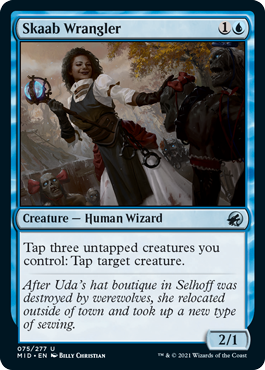
Skaab Wrangler
{1}{U}
Creature — Human Wizard
2/1
Tap three untapped creatures you control: Tap target creature.
- Since Skaab Wrangler’s activated ability doesn’t have a tap symbol in its cost, you can tap creatures that haven’t been under your control since your most recent turn began (including Skaab Wrangler itself) to pay the cost.
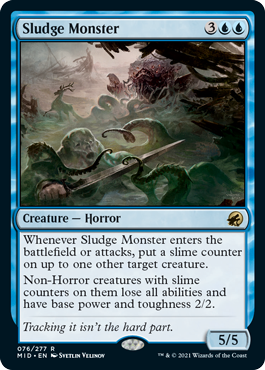
Sludge Monster
{3}{U}{U}
Creature — Horror
5/5
Whenever Sludge Monster enters the battlefield or attacks, put a slime counter on up to one other target creature.
Non-Horror creatures with slime counters on them lose all abilities and have base power and toughness 2/2.
- Sludge Monster’s last ability affects all non-Horror creatures with slime counters on them, not just creatures that had slime counters put on them with Sludge Monster’s first ability.
- If a non-Horror creature with a slime counter on it somehow becomes a Horror, the effect making it 2/2 and making it lose its abilities ends. Its base power and toughness will revert to whatever it was before that effect started applying, although other effects that modify power and/or toughness, such as ones created by Auras, counters, and the like may still apply. It’ll also have whatever abilities it had before it lost them.
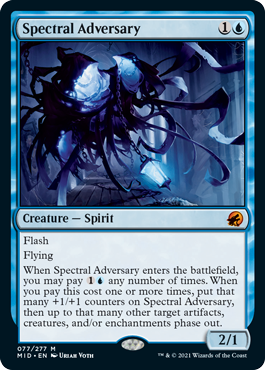
Spectral Adversary
{1}{U}
Creature — Spirit
2/1
Flash
Flying
When Spectral Adversary enters the battlefield, you may pay {1}{U} any number of times. When you pay this cost one or more times, put that many +1/+1 counters on Spectral Adversary, then up to that many other target artifacts, creatures, and/or enchantments phase out.
- After you pay the {1}{U} cost one or more times, a second ability triggers and you choose the targets for it. Players may respond to the new ability at that point. As that ability resolves, Spectral Adversary gets its +1/+1 counters and the target permanents phase out.
- Permanents that are phased out are treated as though they don’t exist. They can’t be the target of spells or abilities, their static abilities have no effect on the game, their triggered abilities can’t trigger, they can’t attack or block, and so on.
- As a permanent phases out, Auras and Equipment attached to it also phase out at the same time. Those Auras and Equipment will phase in at the same time that permanent does, and they’ll phase in still attached to that permanent.
- Permanents phase back in during their controller’s untap step, immediately before that player untaps their permanents. Creatures that phase in this way are able to attack and pay a cost of {T} during that turn. If a permanent had counters on it when it phased out, it will have those counters when it phases back in.
- An attacking or blocking creature that phases out is removed from combat.
- Phasing out doesn’t cause any “leaves the battlefield” abilities to trigger. Similarly, phasing in won’t cause any “enters the battlefield” abilities to trigger.
- Any continuous effects with a “for as long as” duration ignore phased-out objects. If ignoring those objects causes the effect’s conditions to no longer be met, the duration will expire. For example, phasing out Mind Flayer will cause the duration of its continuous effect (“for as long as you control Mind Flayer”) to expire.
- Choices made for permanents as they entered the battlefield are remembered when they phase in.
- If an opponent gains control of one of your permanents, that permanent phases out, and the duration of the control-change effect expires before it phases back in, that permanent phases in under your control as that opponent’s next untap step begins. If they leave the game before their next untap step, it phases in as the next untap step begins after their turn would have begun.
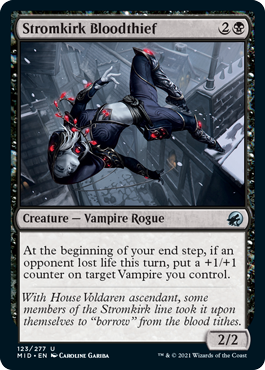
Stromkirk Bloodthief
{2}{B}
Creature — Vampire Rogue
2/2
At the beginning of your end step, if an opponent lost life this turn, put a +1/+1 counter on target Vampire you control.
- Stromkirk Bloodthief’s ability cares whether an opponent lost life this turn, not how their life total changed. For example, an opponent who gained 2 life and lost 1 life in the same turn still lost life.
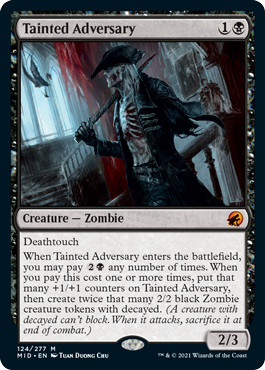
Tainted Adversary
{1}{B}
Creature — Zombie
2/3
Deathtouch
When Tainted Adversary enters the battlefield, you may pay {2}{B} any number of times. When you pay this cost one or more times, put that many +1/+1 counters on Tainted Adversary, then create twice that many 2/2 black Zombie creature tokens with decayed. (A creature with decayed can’t block. When it attacks, sacrifice it at end of combat.)
- After you pay the {2}{B} cost one or more times, a second ability triggers. Players may respond to the new ability at that point. As that ability resolves, Tainted Adversary gets its counters and the tokens are created.
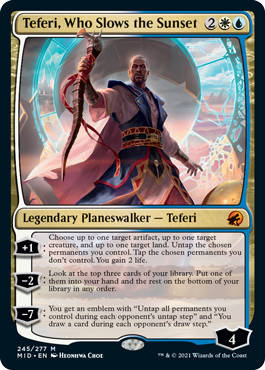
Teferi, Who Slows the Sunset
{2}{W}{U}
Legendary Planeswalker — Teferi
4
+1: Choose up to one target artifact, up to one target creature, and up to one target land. Untap the chosen permanents you control. Tap the chosen permanents you don’t control. You gain 2 life.
−2: Look at the top three cards of your library. Put one of them into your hand and the rest on the bottom of your library in any order.
−7: You get an emblem with “Untap all permanents you control during each opponent’s untap step” and “You draw a card during each opponent’s draw step.”
- If one or more targets are illegal as the first ability resolves, but at least one target is still legal, the ability will affect only the remaining legal targets and you’ll gain 2 life.
- If you create an emblem with the last ability, your permanents will untap at the same time as your opponent’s permanents during their untap step. They will draw a card during their draw step and then you will draw a card during their draw step. No player gets priority to cast spells or activate abilities between those card draws.
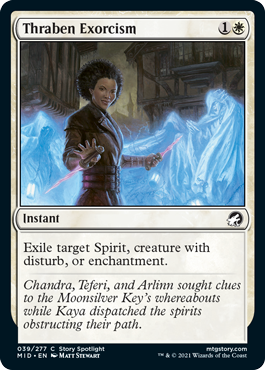
Thraben Exorcism
{1}{W}
Instant
Exile target Spirit, creature with disturb, or enchantment.
- A creature with disturb is one that has the disturb keyword ability in its text box. Notably, permanents that were cast using the disturb ability rarely end up having disturb on the battlefield. Barring some very weird circumstances with copy effects, if a card’s front face has disturb but its back face is on the battlefield, that permanent doesn’t have disturb.
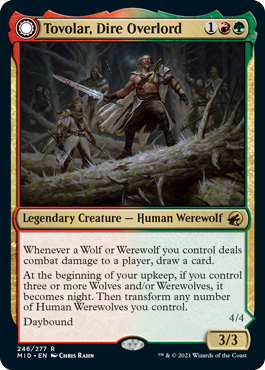
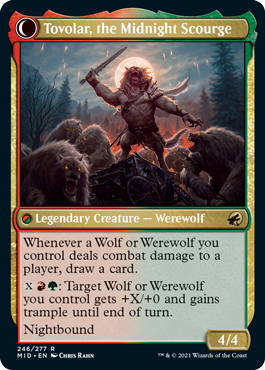
Tovolar, Dire Overlord
{1}{R}{G}
Legendary Creature — Human Werewolf
3/3
Whenever a Wolf or Werewolf you control deals combat damage to a player, draw a card.
At the beginning of your upkeep, if you control three or more Wolves and/or Werewolves, it becomes night. Then transform any number of Human Werewolves you control.
Daybound
////
Tovolar, the Midnight Scourge
Legendary Creature — Werewolf
4/4
Whenever a Wolf or Werewolf you control deals combat damage to a player, draw a card.
{X}{R}{G}: Target Wolf or Werewolf you control gets +X/+0 and gains trample until end of turn.
Nightbound
- The first ability of each of Tovolar’s faces triggers once for each Wolf or Werewolf you control that deals combat damage to a player. For example, if you attack with three Wolf creatures and they all deal combat damage to a player, the ability triggers three times.
- If a creature you control that’s a Wolf and a Werewolf deals combat damage to a player, the first ability triggers only once.
- The second ability of Tovolar, Dire Overlord seems a little strange because Tovolar and other Human Werewolf creatures in this set transform when it becomes night anyway. Tovolar, however, isn’t content to transform Werewolf creatures from just one set. This ability will allow you to transform Human Werewolf creatures from previous visits to Innistrad as well.
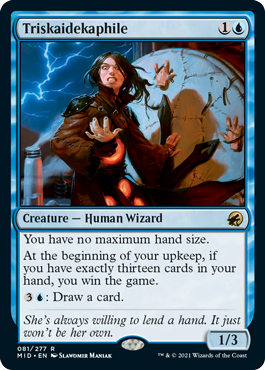
Triskaidekaphile
{1}{U}
Creature — Human Wizard
1/3
You have no maximum hand size.
At the beginning of your upkeep, if you have exactly thirteen cards in your hand, you win the game.
{3}{U}: Draw a card.
- Triskaidekaphile’s triggered ability will trigger only if you have exactly thirteen cards in your hand as your upkeep starts. If you have fewer cards in your hand, you won’t be able to draw cards during your upkeep in time to cause the ability to trigger.
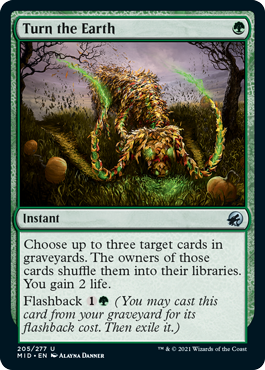
Turn the Earth
{G}
Instant
Choose up to three target cards in graveyards. The owners of those cards shuffle them into their libraries. You gain 2 life.
Flashback {1}{G} (You may cast this card from your graveyard for its flashback cost. Then exile it.)
- If you choose target cards in graveyards and all of those targets are somehow illegal as Turn the Earth tries to resolve (perhaps because your opponent responded with a Turn the Earth of their own), the spell will not resolve and you will gain no life.
- You may choose no targets for Turn the Earth. In that case, no libraries will be shuffled and you’ll just gain 2 life.
- Each affected library is shuffled only once, even if multiple cards are being shuffled into it.
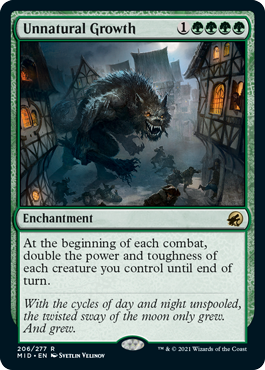
Unnatural Growth
{1}{G}{G}{G}{G}
Enchantment
At the beginning of each combat, double the power and toughness of each creature you control until end of turn.
- If an effect instructs you to “double” a creature’s power, that creature gets +X/+0, where X is its power as that effect begins to apply. Similarly, a creature whose toughness is doubled gets +0/+X, where X is its toughness as the effect begins to apply.
- If a creature’s power is less than 0 when it’s doubled, instead that creature gets -X/-0, where X is how much less than 0 its power is. For example, if an effect has given Bear Cub, a 2/2 creature, -4/-0 so that it’s a -2/2 creature, doubling its power and toughness gives it -2/+2, and it becomes a -4/4 creature.
- If you control more than one Unnatural Growth, each one applies independently. For example, if you control two copies of Unnatural Growth, a 2/2 Bear Cub becomes a 4/4 creature when the first ability resolves and then becomes an 8/8 creature when the second one resolves.
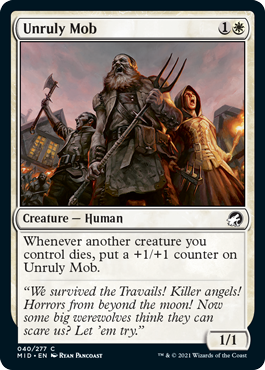
Unruly Mob
{1}{W}
Creature — Human
1/1
Whenever another creature you control dies, put a +1/+1 counter on Unruly Mob.
- If Unruly Mob and another creature you control die simultaneously (perhaps because they were both attacking or blocking), Unruly Mob won’t be on the battlefield as its triggered ability resolves. It can’t be saved by the +1/+1 counter that would have been put on it.
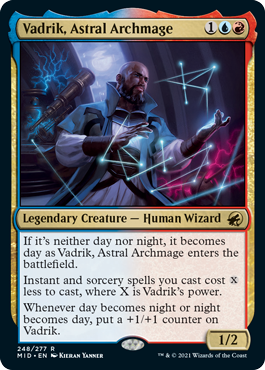
Vadrik, Astral Archmage
{1}{U}{R}
Legendary Creature — Human Wizard
1/2
If it’s neither day nor night, it becomes day as Vadrik, Astral Archmage enters the battlefield.
Instant and sorcery spells you cast cost {X} less to cast, where X is Vadrik’s power.
Whenever day becomes night or night becomes day, put a +1/+1 counter on Vadrik.
- All costs to cast a spell are locked in before mana abilities are activated and those costs are paid. If Vadrik’s power changes after costs are locked in, or if Vadrik leaves the battlefield while you are activating mana abilities or paying those costs, the cost reduction effect won’t be affected and the total cost to cast the spell won’t change.
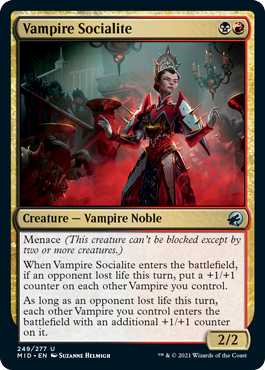
Vampire Socialite
{B}{R}
Creature — Vampire Noble
2/2
Menace (This creature can’t be blocked except by two or more creatures.)
When Vampire Socialite enters the battlefield, if an opponent lost life this turn, put a +1/+1 counter on each other Vampire you control.
As long as an opponent lost life this turn, each other Vampire you control enters the battlefield with an additional +1/+1 counter on it.
- Vampire Socialite’s last two abilities care whether an opponent lost life this turn, not how their life total changed. For example, an opponent who gained 2 life and lost 1 life in the same turn still lost life.
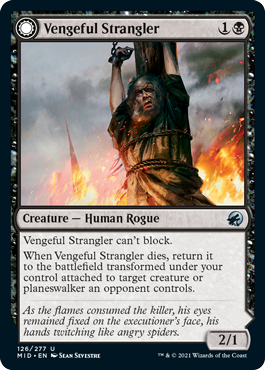
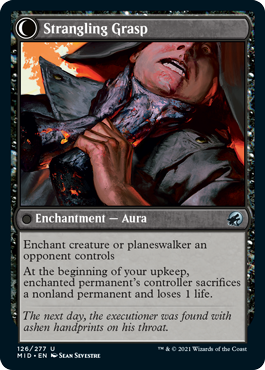
Vengeful Strangler
{1}{B}
Creature — Human Rogue
2/1
Vengeful Strangler can’t block.
When Vengeful Strangler dies, return it to the battlefield transformed under your control attached to target creature or planeswalker an opponent controls.
////
Strangling Grasp
Enchantment — Aura
Enchant creature or planeswalker an opponent controls
At the beginning of your upkeep, enchanted permanent’s controller sacrifices a nonland permanent, then that player loses 1 life.
- If an effect causes Vengeful Strangler to transform on the battlefield, rather than leaving it and returning transformed, then Strangling Grasp doesn’t become attached to any object and is put into your graveyard. This won’t cause abilities that trigger when a creature leaves the battlefield to trigger.
- Strangling Grasp has received a minor update to its wording to clarify the timing of its effect. The updated wording is provided above.
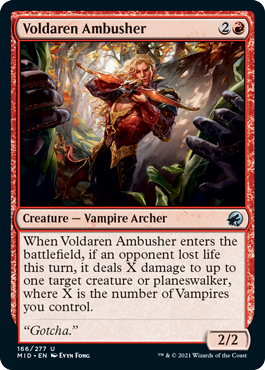
Voldaren Ambusher
{2}{R}
Creature — Vampire Archer
2/2
When Voldaren Ambusher enters the battlefield, if an opponent lost life this turn, it deals X damage to up to one target creature or planeswalker, where X is the number of Vampires you control.
- Voldaren Ambusher’s ability cares whether an opponent lost life this turn, not how their life total changed. For example, an opponent who gained 2 life and lost 1 life in the same turn still lost life.
- Voldaren Ambusher’s ability counts the number of Vampires you control as it resolves. If something happens in response such that you don’t control any Vampires when it resolves, Voldaren Ambusher won’t deal damage to the target creature or planeswalker.
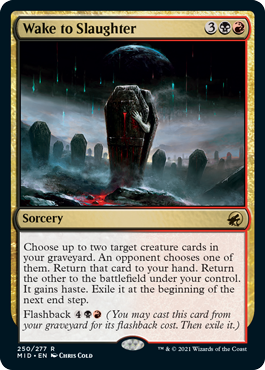
Wake to Slaughter
{3}{B}{R}
Sorcery
Choose up to two target creature cards in your graveyard. An opponent chooses one of them. Return that card to your hand. Return the other to the battlefield under your control. It gains haste. Exile it at the beginning of the next end step.
Flashback {4}{B}{R} (You may cast this card from your graveyard for its flashback cost. Then exile it.)
- If only one target is still legal as Wake to Slaughter resolves (or if you only chose one target), that’s the card your opponent will have to choose to put into your hand. They can’t choose to have you return it to the battlefield.
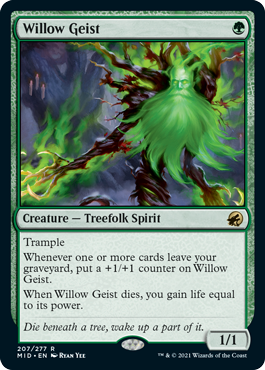
Willow Geist
{G}
Creature — Treefolk Spirit
1/1
Trample
Whenever one or more cards leave your graveyard, put a +1/+1 counter on Willow Geist.
When Willow Geist dies, you gain life equal to its power.
- Use Willow Geist’s power as it last existed on the battlefield to determine how much life you will gain as its last ability resolves.
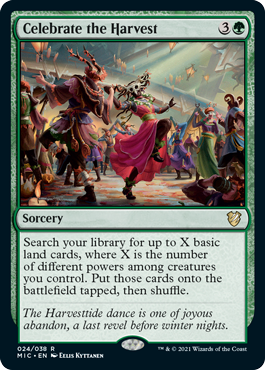
Celebrate the Harvest
{3}{G}
Sorcery
Search your library for up to X basic land cards, where X is the number of different powers among creatures you control. Put those cards onto the battlefield tapped, then shuffle.
- Celebrate the Harvest looks at the creatures you control as it resolves to determine how many basic lands cards you can search for. For example, if you control a 1/1 creature and a 2/1 creature at that time, there are two different powers among creatures you control.
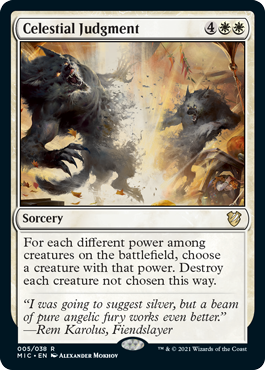
Celestial Judgment
{4}{W}{W}
Sorcery
For each different power among creatures on the battlefield, choose a creature with that power. Destroy each creature not chosen this way.
- No creatures are targeted by Celestial Judgment, so all choices are made as the spell resolves. Notably, no players may respond or take any actions between the creatures being chosen and the other creatures being destroyed.
- All creatures that aren’t chosen are destroyed simultaneously. They see each other leave the battlefield for the purpose of triggered abilities.
- If there are multiple creatures with the same power on the battlefield, you may choose any of them, even if one of them wouldn’t be destroyed. For example, if you control a 2-power creature with indestructible and a 2-power creature with no abilities, you may choose the second one even though the first one can’t be destroyed by Celestial Judgment.
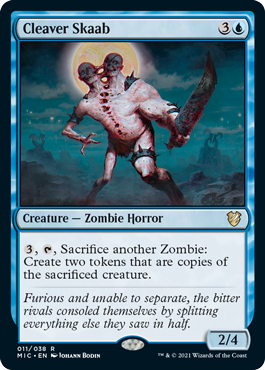
Cleaver Skaab
{3}{U}
Creature — Zombie Horror
2/4
{3}, {T}, Sacrifice another Zombie: Create two tokens that are copies of the sacrificed creature.
- You can choose to sacrifice a Zombie token to activate the ability. You’ll create two tokens that are copies of that token as normal.
- If the sacrificed Zombie was itself copying a permanent, the tokens will be copies of whatever it was copying, as modified by that copy effect. The tokens won’t copy any other effects that were applying to the sacrificed creature, including effects that changed its types, color, power, or toughness while it was on the battlefield.
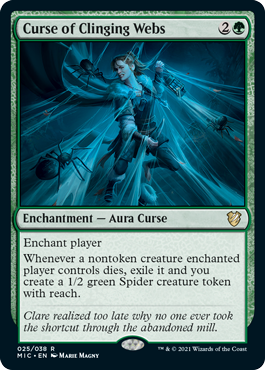
Curse of Clinging Webs
{2}{G}
Enchantment — Aura Curse
Enchant player
Whenever a nontoken creature enchanted player controls dies, exile it and you create a 1/2 green Spider creature token with reach.
- The controller of Curse of Clinging Webs gets the Spider token. This may not be the same player as the enchanted player.
- Exiling the card isn’t required to get the Spider token. You just do so if you can. If that card isn’t in its owner’s graveyard as the ability is resolving, you just create the Spider token.
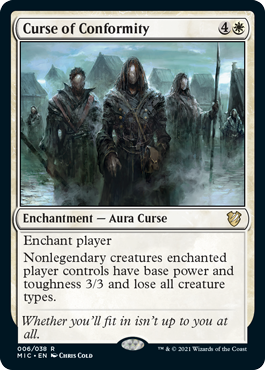
Curse of Conformity
{4}{W}
Enchantment — Aura Curse
Enchant player
Nonlegendary creatures enchanted player controls have base power and toughness 3/3 and lose all creature types.
- Effects that modify a creature’s power and/or toughness, such as the effect of Titanic Growth, will apply to the affected creatures no matter when they started to take effect. The same is true for any counters that change their power and/or toughness.
- Creatures with the changeling ability will still lose all creature types even though they don’t lose changeling.
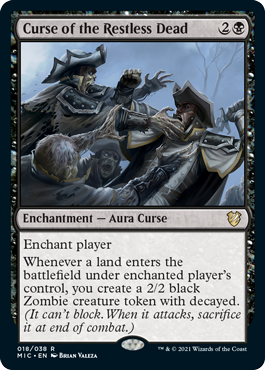
Curse of the Restless Dead
{2}{B}
Enchantment — Aura Curse
Enchant player
Whenever a land enters the battlefield under enchanted player’s control, you create a 2/2 black Zombie creature token with decayed. (It can’t block. When it attacks, sacrifice it at end of combat.)
- The controller of Curse of the Restless Dead gets the Zombie token. This may not be the same player as the enchanted player.
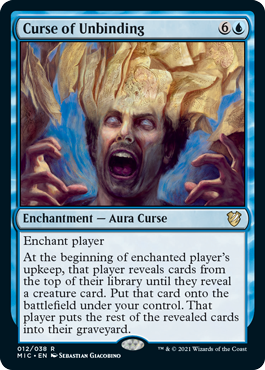
Curse of Unbinding
{6}{U}
Enchantment — Aura Curse
Enchant player
At the beginning of enchanted player’s upkeep, that player reveals cards from the top of their library until they reveal a creature card. Put that card onto the battlefield under your control. That player puts the rest of the revealed cards into their graveyard.
- The controller of Curse of Unbinding puts the creature card onto the battlefield under their control. This may not be the same player as the enchanted player.
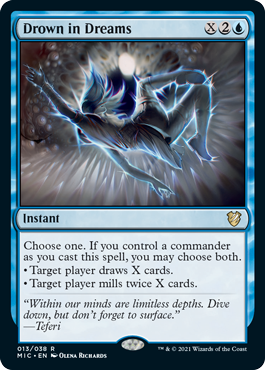
Drown in Dreams
{X}{2}{U}
Instant
Choose one. If you control a commander as you cast this spell, you may choose both.
• Target player draws X cards.
• Target player mills twice X cards.
- Controlling a commander means that you control a permanent on the battlefield that is someone’s commander. It can be yours or another player’s. Controlling a commander spell on the stack will not allow you to choose both modes.
- You may target the same player with both modes or target different players. The effects happen in the order they’re listed on the card.
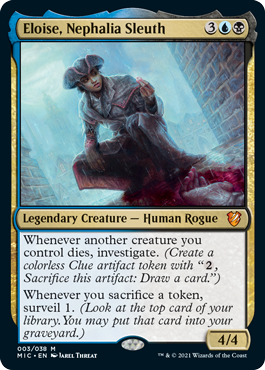
Eloise, Nephalia Sleuth
{3}{U}{B}
Legendary Creature — Human Rogue
4/4
Whenever another creature you control dies, investigate. (To investigate, create a colorless Clue artifact token with “{2}, Sacrifice this artifact: Draw a card.”)
Whenever you sacrifice a token, surveil 1. (Look at the top card of your library. You may put that card into your graveyard.)
- If you sacrifice a Clue token, Eloise’s last ability will trigger in response. You’ll surveil before drawing the card.
- Eloise’s last ability triggers whenever you sacrifice any token for any reason, not just whenever you sacrifice Clue tokens.
- If you create a token that’s a copy of Eloise and both are legendary, you will choose either the token or the original Eloise to keep and put the other into the graveyard. This is not the same as sacrificing it. Putting the token into the graveyard won’t cause nontoken Eloise’s last ability to trigger.
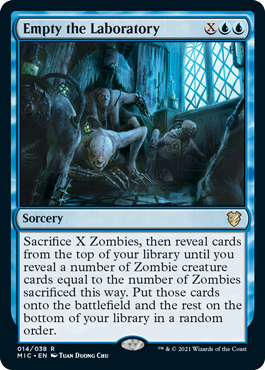
Empty the Laboratory
{X}{U}{U}
Sorcery
Sacrifice X Zombies, then reveal cards from the top of your library until you reveal a number of Zombie creature cards equal to the number of Zombies sacrificed this way. Put those cards onto the battlefield and the rest on the bottom of your library in a random order.
- The Zombies will enter the battlefield simultaneously. They will see each other enter for the purposes of triggered abilities.
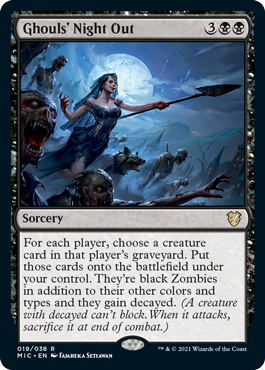
Ghouls’ Night Out
{3}{B}{B}
Sorcery
For each player, choose a creature card in that player’s graveyard. Put those cards onto the battlefield under your control. They’re black Zombies in addition to their other colors and types and they gain decayed. (A creature with decayed can’t block. When it attacks, sacrifice it at end of combat.)
- The creatures will enter the battlefield simultaneously. They will see each other enter for the purposes of triggered abilities.
- If any creature cards put onto the battlefield this way become permanents that aren’t creatures because of another effect, those permanents won’t be Zombies, but they will gain decayed.
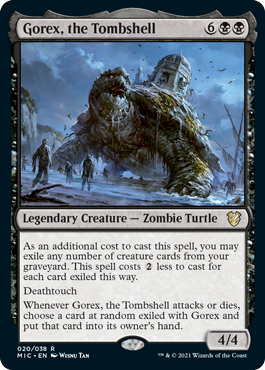
Gorex, the Tombshell
{6}{B}{B}
Legendary Creature — Zombie Turtle
4/4
As an additional cost to cast this spell, you may exile any number of creature cards from your graveyard. This spell costs {2} less to cast for each card exiled this way.
Deathtouch
Whenever Gorex, the Tombshell attacks or dies, choose a card at random exiled with Gorex and put that card into its owner’s hand.
- Gorex’s first ability can’t reduce its cost below {B}{B}. You can exile any number of creature cards from your graveyard, even if they won’t reduce Gorex’s cost any further.
- Include any additional costs to cast Gorex before applying its own cost reduction. For example, if Gorex is your commander and an additional cost of {6} applies from the “commander tax,” you may cast Gorex by exiling four creature cards from your graveyard and paying {4}{B}{B}.
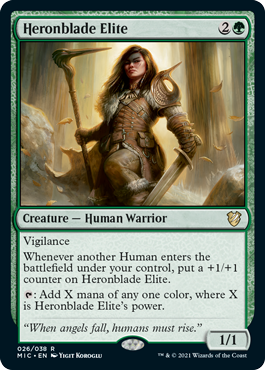
Heronblade Elite
{2}{G}
Creature — Human Warrior
1/1
Vigilance
Whenever another Human enters the battlefield under your control, put a +1/+1 counter on Heronblade Elite.
{T}: Add X mana of any one color, where X is Heronblade Elite’s power.
- Heronblade Elite’s last ability is a mana ability. It doesn’t use the stack and can’t be responded to. If Heronblade Elite’s power is 0 or less at the time the ability resolves, no mana is added.
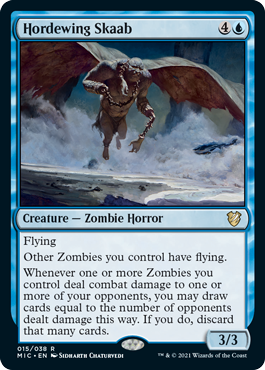
Hordewing Skaab
{4}{U}
Creature — Zombie Horror
3/3
Flying
Other Zombies you control have flying.
Whenever one or more Zombies you control deal combat damage to one or more of your opponents, you may draw cards equal to the number of opponents dealt damage this way. If you do, discard that many cards.
- The number of cards you discard is equal to the number of opponents that were dealt combat damage by your Zombies, even if another effect changed the number of cards you drew.
- If some of your Zombies have first strike but others don’t, or if you have a Zombie with double strike, the ability will trigger twice, the first time counting the number of opponents who were dealt damage in the first strike combat damage step, and the second time counting the ones who were dealt damage in the second combat damage step.
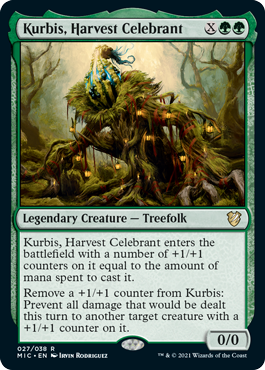
Kurbis, Harvest Celebrant
{X}{G}{G}
Legendary Creature — Treefolk
0/0
Kurbis, Harvest Celebrant enters the battlefield with a number of +1/+1 counters on it equal to the amount of mana spent to cast it.
Remove a +1/+1 counter from Kurbis: Prevent all damage that would be dealt this turn to another target creature with a +1/+1 counter on it.
- Kurbis enters with a number of +1/+1 counters on it equal to the total mana spent to cast it, and that number usually won’t be the same as X. If you cast Kurbis for {G}{G}, it will enter the battlefield with two +1/+1 counters on it.
- If you copy Kurbis while it is on the stack (perhaps using an effect like that of Double Major), the copy wasn’t cast, so no mana was spent to cast it. That Kurbis will enter with zero +1/+1 counters on it.
- Similarly, if you create a token that’s a copy of Kurbis, or if a card enters the battlefield as a copy of Kurbis without being cast, it enters with zero +1/+1 counters on it.
- If a resolving spell enters the battlefield as a copy of Kurbis, it will enter the battlefield with a number of +1/+1 counters equal to the mana spent to cast the spell. For example, if you spend {3}{U} to cast Clone and choose to have it copy Kurbis as it enters the battlefield, it will enter with four +1/+1 counters on it because four mana was spent to cast Clone.
- Once the activated ability resolves, damage will be prevented even if the creature later loses all of its +1/+1 counters.
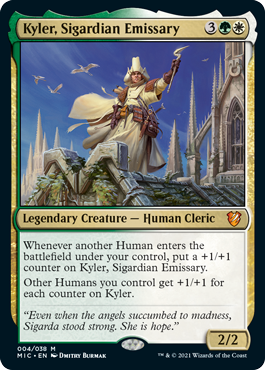
Kyler, Sigardian Emissary
{3}{G}{W}
Legendary Creature — Human Cleric
2/2
Whenever another Human enters the battlefield under your control, put a +1/+1 counter on Kyler, Sigardian Emissary.
Other Humans you control get +1/+1 for each counter on Kyler.
- If Kyler enters the battlefield at the same time as other Humans you control, Kyler’s first ability will trigger once for each of those Humans.
- Kyler’s second ability counts all counters, not just +1/+1 counters.
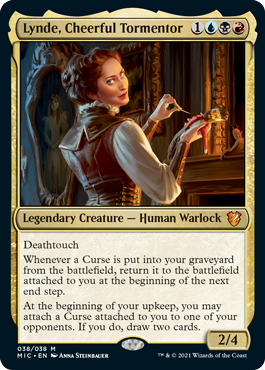
Lynde, Cheerful Tormentor
{1}{U}{B}{R}
Legendary Creature — Human Warlock
2/4
Deathtouch
Whenever a Curse is put into your graveyard from the battlefield, return it to the battlefield attached to you at the beginning of the next end step.
At the beginning of your upkeep, you may attach a Curse attached to you to one of your opponents. If you do, draw two cards.
- Lynde’s last ability doesn’t target, so you can use it to attach a Curse to a player who has hexproof.
- In a multiplayer game, if a player enchanted by one of your Curses leaves the game, perhaps because they have been tormented too much by Lynde, that Curse will be put into your graveyard and cause Lynde’s first triggered ability to trigger.
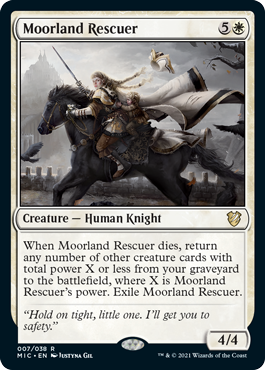
Moorland Rescuer
{5}{W}
Creature — Human Knight
4/4
When Moorland Rescuer dies, return any number of other creature cards with total power X or less from your graveyard to the battlefield, where X is Moorland Rescuer’s power. Exile Moorland Rescuer.
- Moorland Rescuer’s ability uses the power Moorland Rescuer had when it was last on the battlefield, not its power in the graveyard.
- If Moorland Rescuer is exiled from its owner’s graveyard in response to its triggered ability, the creature cards will still be returned to the battlefield.
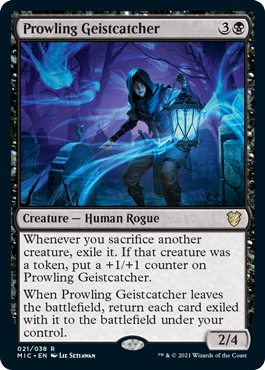
Prowling Geistcatcher
{3}{B}
Creature — Human Rogue
2/4
Whenever you sacrifice another creature, exile it. If that creature was a token, put a +1/+1 counter on Prowling Geistcatcher.
When Prowling Geistcatcher leaves the battlefield, return each card exiled with it to the battlefield under your control.
- If you sacrifice a nontoken creature you control but don’t own, Prowling Geistcatcher will still cause you to exile that card from its owner’s graveyard. The card will be returned to the battlefield under your control with the rest of the exiled cards when Prowling Geistcatcher’s last ability resolves.
- If you sacrifice a creature token you control but don’t own, you will still put a +1/+1 counter on Prowling Geistcatcher.
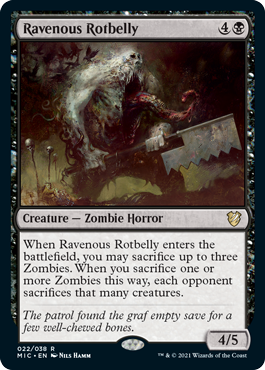
Ravenous Rotbelly
{4}{B}
Creature — Zombie Horror
4/5
When Ravenous Rotbelly enters the battlefield, you may sacrifice up to three Zombies. When you sacrifice one or more Zombies this way, each opponent sacrifices that many creatures.
- After you sacrifice one or more Zombies, a second ability triggers. Players may respond to it before they have to sacrifice creatures.
- As the reflexive triggered ability resolves, first the next opponent in turn order (or, if it’s an opponent’s turn, the opponent whose turn it is) chooses the creatures they plan to sacrifice. Then each other opponent in turn order does the same. Finally all chosen creatures are sacrificed at the same time.
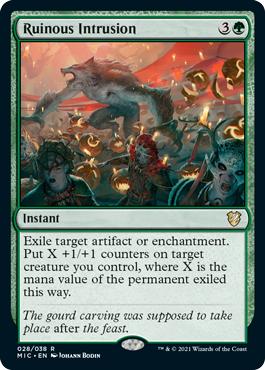
Ruinous Intrusion
{3}{G}
Instant
Exile target artifact or enchantment. Put X +1/+1 counters on target creature you control, where X is the mana value of the permanent exiled this way.
- Use the permanent’s characteristics as it last existed on the battlefield to determine the value of X.
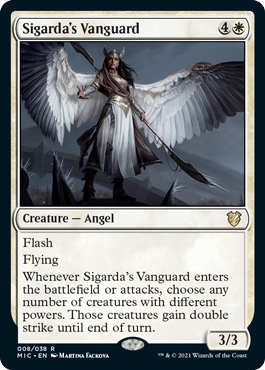
Sigarda’s Vanguard
{4}{W}
Creature — Angel
3/3
Flash
Flying
Whenever Sigarda’s Vanguard enters the battlefield or attacks, choose any number of creatures with different powers. Those creatures gain double strike until end of turn.
- A set of creatures has different powers if every creature’s power is a different value. For example, a 1/1 creature, a 2/1 creature, and a 3/1 creature all have different powers.
- No creatures are targeted by Sigarda’s Vanguard’s ability. The set of creatures is chosen as the ability resolves. You may choose a single creature as a valid set. If you do, that creature will gain double strike until end of turn.
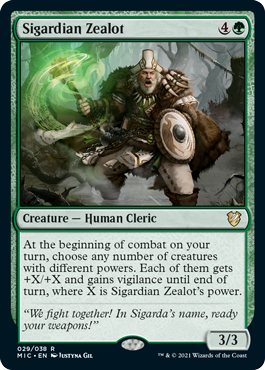
Sigardian Zealot
{4}{G}
Creature — Human Cleric
3/3
At the beginning of combat on your turn, choose any number of creatures with different powers. Each of them gets +X/+X and gains vigilance until end of turn, where X is Sigardian Zealot’s power.
- A set of creatures has different powers if every creature’s power is a different value. For example, a 1/1 creature, a 2/1 creature, and a 3/1 creature all have different powers.
- No creatures are targeted by Sigardian Zealot’s ability. The set of creatures is chosen as the ability resolves. You may choose a single creature as a valid set. If you do, that creature will get +X/+X and gain vigilance until end of turn.
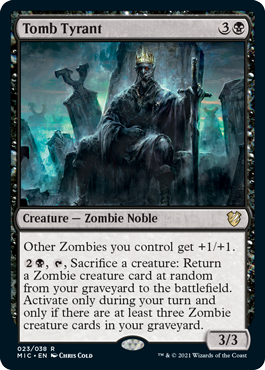
Tomb Tyrant
{3}{B}
Creature — Zombie Noble
3/3
Other Zombies you control get +1/+1.
{2}{B}, {T}, Sacrifice a creature: Return a Zombie creature card at random from your graveyard to the battlefield. Activate only during your turn and only if there are at least three Zombie creature cards in your graveyard.
- You need at least three Zombie creature cards in your graveyard before you begin to activate Tomb Tyrant’s activated ability. You can’t begin to activate it with two and plan to sacrifice a Zombie for the third.
- If the creature you sacrifice to pay the cost is a Zombie card, it will be among the cards that may be chosen.
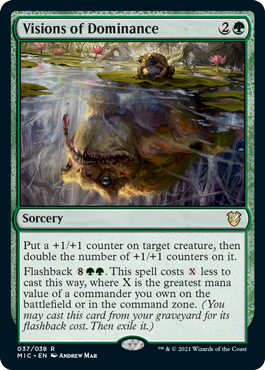
Visions of Dominance
{2}{G}
Sorcery
Put a +1/+1 counter on target creature, then double the number of +1/+1 counters on it.
Flashback {8}{G}{G}. This spell costs {X} less to cast this way, where X is the greatest mana value of a commander you own on the battlefield or in the command zone. (You may cast this card from your graveyard for its flashback cost. Then exile it.)
- To double the number of +1/+1 counters on a permanent, put a number of +1/+1 counters on it equal to the number it already has. Other cards that interact with putting counters on it will interact with this effect accordingly.
- If your commander is under the control of another player as you cast Visions of Dominance using its flashback ability, that commander’s mana value can be used to determine the value of X.
- The cost-reduction effect that applies if you cast Visions of Dominance using flashback applies only to the generic portion of the cost to cast it, although it can apply to any additional costs there may be to cast the spell. It can’t reduce any colored mana required to cast the spell.
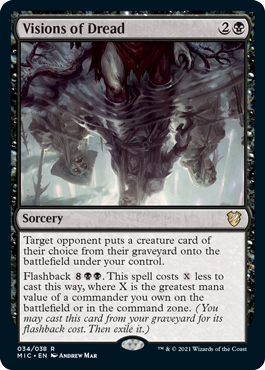
Visions of Dread
{2}{B}
Sorcery
Target opponent puts a creature card of their choice from their graveyard onto the battlefield under your control.
Flashback {8}{B}{B}. This spell costs {X} less to cast this way, where X is the greatest mana value of a commander you own on the battlefield or in the command zone. (You may cast this card from your graveyard for its flashback cost. Then exile it.)
- If you leave the game while controlling permanents owned by other players that entered the battlefield under your control, those permanents are exiled. If the other players leave the game, they take their cards with them. (By contrast, if you leave the game while controlling permanents owned by another player you gained control of, those control-changing effects end and the permanents return to their previous controllers.)
- If your commander is under the control of another player as you cast Visions of Dread using its flashback ability, that commander’s mana value can be used to determine the value of X.
- The cost-reduction effect that applies if you cast Visions of Dread using flashback applies only to the generic portion of the cost to cast it, although it can apply to any additional costs there may be to cast the spell. It can’t reduce any colored mana required to cast the spell.
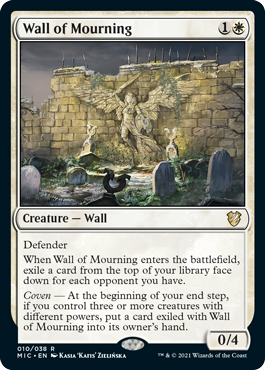
Wall of Mourning
{1}{W}
Creature — Wall
0/4
Defender
When Wall of Mourning enters the battlefield, exile a card from the top of your library face down for each opponent you have.
Coven — At the beginning of your end step, if you control three or more creatures with different powers, put a card exiled with Wall of Mourning into its owner’s hand.
- You don’t get to look at the cards exiled with Wall of Mourning. If there are more than one, you choose which one to put back into your hand at random without looking at them. This is true even if you knew what one or more cards from the top of your library were before exiling them.
Magic: The Gathering, Magic, Innistrad, Throne of Eldraine, Theros, and Ikoria are trademarks of Wizards of the Coast LLC in the USA and other countries. ©2021 Wizards.
[ad_2]





